Unwanted Rejects
Unwanted Rejects
(?)Community Member
- Report Post
- Posted: Wed, 16 Dec 2009 14:29:24 +0000
.
.
.
.

 Abide by the Gaia TOS, and all forum/general rules
Abide by the Gaia TOS, and all forum/general rules
 NO ART THEFT
NO ART THEFT
 Do not use another person’s pet.
Do not use another person’s pet.
 Be respectful of others- don’t start fights in my shop.
Be respectful of others- don’t start fights in my shop.
 All sales are final, including customs. If your custom specifications have not been met, then please feel free to mail.
All sales are final, including customs. If your custom specifications have not been met, then please feel free to mail.
 All Flatsale and Raffle payments are to be made in pure gold, unless otherwise stated.
All Flatsale and Raffle payments are to be made in pure gold, unless otherwise stated.
 All certing info needs posted immediately. I'm tired of chasing people down.
All certing info needs posted immediately. I'm tired of chasing people down.
 Pets don't die unless decided by the owner.
Pets don't die unless decided by the owner.
 If you have a question, please refer to the FAQ section BEFORE you mail this account, or a colorist.
If you have a question, please refer to the FAQ section BEFORE you mail this account, or a colorist.
 All payments go to the mule and trades MUST be labeled.
All payments go to the mule and trades MUST be labeled.
 Pets must only be used on Gaia.
Pets must only be used on Gaia.
 All pets are to be saved immediately to your own server.
All pets are to be saved immediately to your own server.
 Follow ALL ordering procedures given in each section.
Follow ALL ordering procedures given in each section.


.
.
.

 Abide by the Gaia TOS, and all forum/general rules
Abide by the Gaia TOS, and all forum/general rules NO ART THEFT
NO ART THEFT Do not use another person’s pet.
Do not use another person’s pet. Be respectful of others- don’t start fights in my shop.
Be respectful of others- don’t start fights in my shop. All sales are final, including customs. If your custom specifications have not been met, then please feel free to mail.
All sales are final, including customs. If your custom specifications have not been met, then please feel free to mail. All Flatsale and Raffle payments are to be made in pure gold, unless otherwise stated.
All Flatsale and Raffle payments are to be made in pure gold, unless otherwise stated. All certing info needs posted immediately. I'm tired of chasing people down.
All certing info needs posted immediately. I'm tired of chasing people down. Pets don't die unless decided by the owner.
Pets don't die unless decided by the owner. If you have a question, please refer to the FAQ section BEFORE you mail this account, or a colorist.
If you have a question, please refer to the FAQ section BEFORE you mail this account, or a colorist. All payments go to the mule and trades MUST be labeled.
All payments go to the mule and trades MUST be labeled. Pets must only be used on Gaia.
Pets must only be used on Gaia. All pets are to be saved immediately to your own server.
All pets are to be saved immediately to your own server. Follow ALL ordering procedures given in each section.
Follow ALL ordering procedures given in each section.New rules may be added as necessary.

White -
<3 Staff, our wonderful lineartist and cert maker <3, all devoted customers biggrin
Gray -
Basically those on this list are on restriction - No one yay
Black -
Anyone here is not welcome in this shop or any event thread/guild associated with it. This also means you may not give grams, pets, or anything else from this shop, to them.
Sesshiyasha
<3 Staff, our wonderful lineartist and cert maker <3, all devoted customers biggrin
Gray -
Basically those on this list are on restriction - No one yay
Black -
Anyone here is not welcome in this shop or any event thread/guild associated with it. This also means you may not give grams, pets, or anything else from this shop, to them.
Sesshiyasha

Unwanted Rejects
(?)Community Member
- Report Post
- Posted: Wed, 16 Dec 2009 14:30:21 +0000
.
.
.
.

Before the Rejects found this land and lived as man's pets and by their rules, they were judged, hated, and shoved away. Those that were to small, the wrong color, or just didn't plain fit were tossed out with no remorse. Man was cruel, they wanted perfection.
Shoved out into the cold and forced to take care of themselves, the creatures were forced into the woods. It's there that they met the dragons and the dragons offered them a land of their own: Free of humans and hatred.
With bright eyes, they gladly accepted. A land to call their own, what was wrong with that? Soon groups were formed. The great Rose Thorp was headed by the mysterious Grey Seers, the mighty packs that stuck to one land or another calling them their own.
The mighty lords that carried wings and sailed the skys, the mysterious and magical Tanuki that only the lucky found. Yet there was more mystery carried all over the land creatures some had never seen before.

.
.
.

Before the Rejects found this land and lived as man's pets and by their rules, they were judged, hated, and shoved away. Those that were to small, the wrong color, or just didn't plain fit were tossed out with no remorse. Man was cruel, they wanted perfection.
Shoved out into the cold and forced to take care of themselves, the creatures were forced into the woods. It's there that they met the dragons and the dragons offered them a land of their own: Free of humans and hatred.
With bright eyes, they gladly accepted. A land to call their own, what was wrong with that? Soon groups were formed. The great Rose Thorp was headed by the mysterious Grey Seers, the mighty packs that stuck to one land or another calling them their own.
The mighty lords that carried wings and sailed the skys, the mysterious and magical Tanuki that only the lucky found. Yet there was more mystery carried all over the land creatures some had never seen before.

Unwanted Rejects
(?)Community Member
- Report Post
- Posted: Wed, 16 Dec 2009 14:31:14 +0000
.
.
.
.

Pink = Female, Purple = Joint, Blue = Male
? = Not currently available

What’s more to say of rats, they crawl, they eat, they breed, and they sleep and get into almost everything, but what’s more they are masters of the food court. This is so much so that they are no longer seen as food, but rather the finders of food. The most common of the subtypes they are social beyond grouping in mass and guarding in full. There is many different types of rats, for different purposes.
One of the largest muroids, it is a rodent with a body up to 25 cm (10 in) long, and a similar tail length; the male weighs on average 350 g (12 oz) and the female 250 g (9 oz).
The length can be up to 25 cm (10 in), with the tail a further 25 cm (10 in), the same length as the body. Adult body weight averages 550 g (19 oz) in males and about 350 g (12 oz) in females, but a very large individual can reach 900 g (32 oz). Rats weighing over 1 kg (2.2 lb) are exceptional.
Rats have acute hearing, are sensitive to ultrasound, and possess a very highly developed olfactory sense. The vision of a pigmented rat is poor, around 20/600, while a non-pigmented (albino) with no melanin in its eyes has both around 20/1200 vision and a terrible scattering of light within its vision. rats are dichromates who perceive colours rather like a human with red-green colorblindness, and their colour saturation may be quite faint. Their blue perception, however, also has UV perceptors, allowing them to see ultraviolet lights that some species cannot.
The rat is usually active at night and is a good swimmer, both on the surface and underwater, they are poor climbers. rats dig well, and often excavate extensive burrow systems.
The rat is a true omnivore and will consume almost anything, but cereals form a substantial part of its diet.
Rats are known to burrow extensively, both in the wild and in captivity, if given access to a suitable substrate.
Burrows provide rats with shelter and food storage as well as safe, thermoregulated nest sites.Rats use their burrows to escape from perceived threats in the surrounding environment—for example, rats will retreat to their burrows following a sudden, loud noise or while fleeing an intruder.
This is why the home of the rats Rose thorp is actually located underground. Tho the tunnels have been made larger to be open to more larger creatures.
Rats often live in huge colony's with hundreds in population, A few larger are controlled by groups rather then a single member, rat colony's are often seen as a dictatorship how ever there are many that aren't. Rats are rarely seen alone.
Stages
Pinky - Stage 0? - Joint Gender - Only via breeding
Baby - Stage 1 - Joint Gender
Teen - Stage 2 - Male and female forms
Adult - Stage 3 - Male and female forms
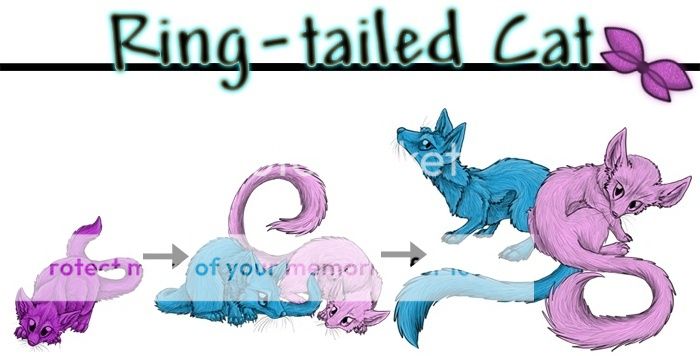
The Ringtail (Bassariscus astutus) is a mammal of the raccoon family (thus not actually a cat)
The eyes are large and purple, each surrounded by a patch of light fur. It is smaller than a housecat, measuring 30–42 cm long with a tail of 31–44 cm and weighing 0.8–1.5 kg.
The ankle joint is flexible and able to rotate over 180 degrees, a trait helping make it an agile climber. Their considerable tail provides balance for negotiating narrow ledges and limbs, even allowing them to reverse directions by performing a cartwheel. Ringtails also can ascend narrow passages by stemming (pressing all feet on one wall and their back against the other or pressing both right feet on one wall and both left feet on the other), and wider cracks or openings by ricocheting between the walls.
This makes the ringtail one of the best scouts around the land.
It is nocturnal, solitary, timid, and rarely seen. It is omnivorous, eating fruits, berries, insects, lizards, small rodents, and birds. Owls, foxes, coyotes, raccoons and bobcats will prey upon ringtails.
Ringtail Cats are the acrobats of the subtypes and second most common, they can get to just about anywhere and in anything.
Ringtails often travel in pairs or solo they have a knack for exploring and are often the scouts of the area. Rarely are they seen in a large pack for very long.
Stages
Baby - Stage 1 - Joint Gender
Teen - Stage 2 - Male and female forms
Adult - Stage 3 - Male and female forms
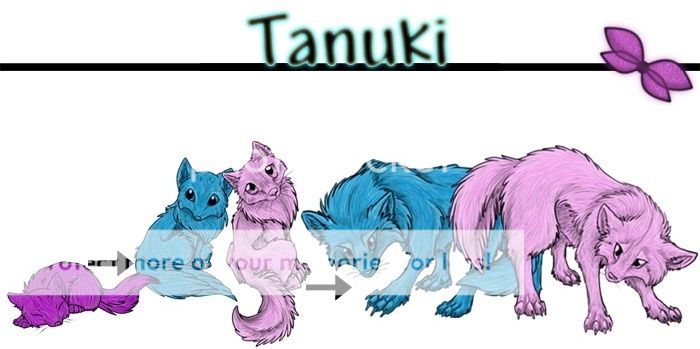
Tanuki or raccoon dog which is the common name not mystical is a member of the canid family.
In reflection of their omnivorous diet, raccoon dogs have small and weak canines and carnassials, flat molars and relatively long intestines (1.5-2 times longer than other canids). They have long torsos and short legs. The tail is short, amounting to less than 1/3 of the animal's total length and hangs below the tarsal joints without touching the ground. The ears are short, and protrude only slightly from the fur. Weight fluctuates according to season; in March, they weigh 3 kg (6.6 lbs), while in August to early September, males average 6.5–7 kg (14-15 lbs), with some individuals attaining a maximal weight of 9–10 kg (20-22 lbs). Average adult head and body length is about 65 cm (2 ft)
Raccoon dogs are omnivores which feed on insects, mouse-like rodents, amphibians, birds, fish, reptiles, molluscs, carrion and insectivores. Frogs are the most commonly taken amphibians; Raccoon dogs will prey on waterfowl, passerines and migrating birds. Raccoon dogs will eat beached fish and fish trapped in small water bodies. They rarely catch fish during the spawning season, but will eat many during the spring thaw. Plant food is highly variable, and includes bulbs, rhizomes, oats, millets, maize, nuts, fruits, berries, grapes, melons, watermelons, pumpkins and tomatoes. they have been observed to climb trees to forage for fruits and berries; raccoon dogs use their curved claws to climb such trees.
Tanuki are considered demigods, these beasts are hardly seen, be them master of disguise or rare to the point of being not seen is unknown. Some claim they are able to shape shift others claim that is nothing but legend. The largest of the subtypes, it is mostly solitary coming together only to breed.
Stages
Baby - Stage 1 - Joint Gender
Child - Stage 2 - male and female forms
Adult - Stage 3 - male and female forms
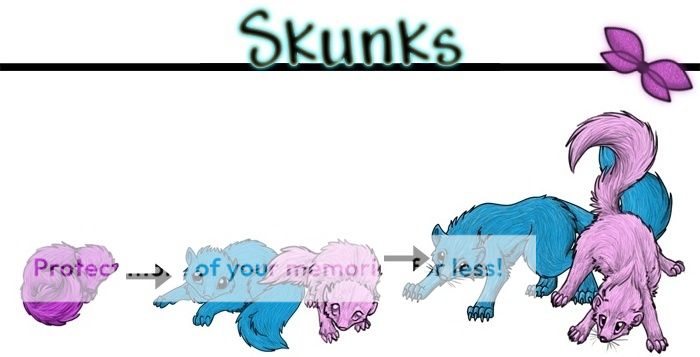
Skunk species vary in size from about 15.6 to 37 inches (40 to 94 cm) and in weight from about 1.1 pounds (0.50 kg) to 18 pounds (8.2 kg). They have a moderately elongated body with relatively short, well-muscled legs, and long front claws for digging.
Skunks are omnivorous, eating both plant and animal material and changing their diet as the seasons change. They eat insects and larvae, earthworms, small rodents, lizards, salamanders, frogs, snakes, birds, moles, and eggs. They also commonly eat berries, roots, leaves, grasses, fungi, and nuts.
Skunks are crepuscular and are solitary animals when not breeding, though in the colder parts of their range they may gather in communal dens for warmth. During the day, they shelter in burrows that they dig with their powerful front claws, or in other man-made or natural hollows as the opportunity arises.
Skunks are probably one of the most dangerous even with out being a meat eater, their smell alone drives most away, having a chance to cause even blindness if taken wrong.
They are often used as guards and guard the opening to rose thorp.
Stages
Baby - Stage 1 - Joint Gender
Child - Stage 2 - Male and female forms
Adult - Stage 3 - Male and Female Forms

Stages
Baby - Stage 1 - Joint Gender
Teen - Stage 2 - Joint Gender
Adult - Stage 3 - Joint Gender
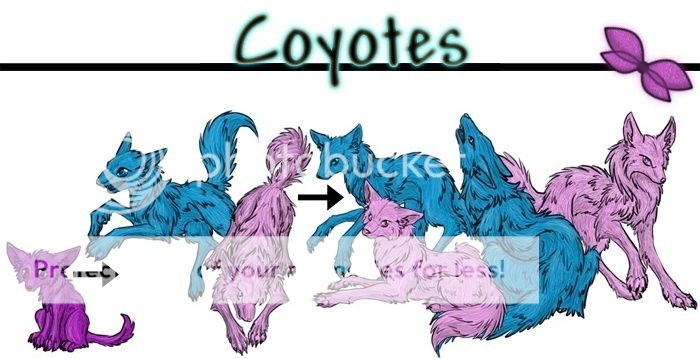
Large Breed Coyote - Small Breed Coyote
The original adult coyotes these tend to be larger and more aggressive then the new counter part. Often seen as the leaders of a pack they tend to be more out going.
Coyote alt adults are much smaller then the original in body mass they are normally quiet faster as they have less to move. Normally given beta ranking in packs or rarely alphas. They are more quiet less aggressive.
Coyotes are mostly nocturnal but seen during the day at some times, they normally hunt in pairs and form small groups. Coyotes are mostly carnivores eating small animals but will eat bugs at times also. Located in all areas including where humans inhabit they will eat even the dead tho they prefer fresh. - Litter size ranges from 1 to 19 pups
Coyotes typically grow up to 75–87 centimeters (30–34 inches) in length and on average, weigh from 7–21 kilograms (15–46 pounds)
Coyotes are pack livers as with most wolfs. Often you may hear one of these animals to never see him, able to stalk prey and confuse their enemies they are more advanced then coyotes of the normal world. But bear the same pack structure.
Alpha – Alpha
Beta – Beta
Gamma
Pups
Omega
Alpha male and female are always mates these are not fully leaders but normally the most out going causing others to follow.
Beta male and female are always mates also these just under the alphas are a form of second
Gammas are the middle coyote no one stands out no one wants to they are fit to follow and that’s all, those that aren’t beta alpha or omega are in this status
Omegas are the den guarders the lowest status of the pack they are often seen with tail down and ears down.
Stages
Baby - Stage 1 - Joint Gender
Child - Stage 2 - Male and female forms
Adult - Stage 3 - Male and female forms - The only Reject currently with 2 forms of adults
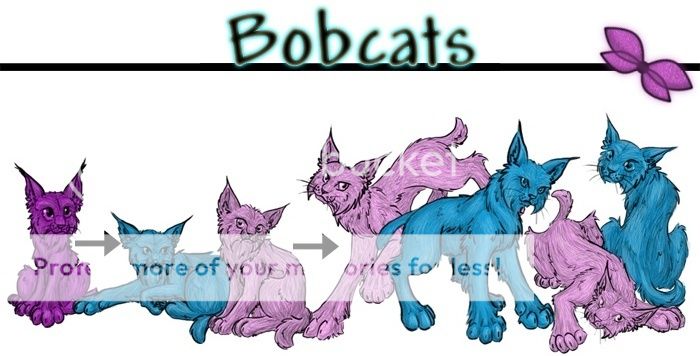
Large Breed Bobcat - Small Breed Bobcat
Though the Bobcat prefers rabbits and hares, it will hunt anything from insects and small rodents to deer. Prey selection depends on location and habitat, season, and abundance. Like most cats, the bobcat is territorial and largely solitary, although there is some overlap in home ranges. It uses several methods to mark its territorial boundaries, including claw marks and deposits of urine or feces.
The Bobcat is crepuscular. It keeps on the move from three hours before sunset until about midnight, and then again from before dawn until three hours after sunrise. Each night it will move from 2 to 7 miles (3.2 to 11 km) along its habitual route. This behavior may vary seasonally, as Bobcats become more diurnal during fall and winter. This is a response to the activity of their prey, which are more active during the day in colder months.
The adult male Bobcat is 28 to 40 inches (71 to 100 cm) long, averaging 35 inches (89 cm); with a stubby 4 to 7 inches (10 to 18 cm) tail, which has a "bobbed" appearance and gives the species its name. An adult stands about 20 to 24 inches (51 to 61 cm) at the shoulders. Adult males usually range from 20 to 30 pounds (9.1 to 14 kg); females average about 13 to 21 pounds (5.9 to 9.5 kg).The Bobcat is muscular, and its hind legs are longer than its front legs, giving it a bobbing gait. At birth it weighs 0.6 to 0.75 pound (270 to 340 g) and is about 10 inches (25 cm) in length. By its first year it will reach about 10 pounds (4.5 kg).
Stages
Baby - Stage 1 - Joint Gender
Child - Stage 2 - Male and female forms
Adult - Stage 3 - Male and female forms

Normal Lions - Barbary Lions - Rogue Lions
Pride standing:
All cubs when born are in the same pride as their parents. There are cubs born to nomads(Loners)
Bought Pets:
A lion bought from sales that have no pride are automatically given a Nomad standing till a pride is found or made.
Lions are the main inhabitant of the Savannah, Unmoved and unpredictable they cover all parts of the lands.
Lions are powerful animals that usually hunt in coordinated groups and stalk their chosen prey. However, they are not particularly known for their stamina they only run fast in short bursts and need to be close to their prey before starting the attack. They take advantage of factors that reduce visibility; many kills take place near some form of cover or at night. Typically, several lionesses work together and encircle the herd from different points. Once they have closed with a herd, they usually target the closest prey. The attack is short and powerful; they attempt to catch the victim with a fast rush and final leap. The prey usually is killed by strangulation. Smaller prey, though, may simply be killed by a swipe of a lion's paw.
The prey consists mainly of large mammals. Occasionally, they take relatively small species. Lions hunting in groups are capable of taking down most animals, even healthy adults.
Lions are predatory carnivores who manifest two types of social organization. Some are residents, living in groups, called prides. Prides may range from a newly formed group to a large group. Male cubs are excluded from their maternal pride when they reach maturity.
The second organizational behavior is labeled nomads, who range widely and move about sporadically, either singularly or in pairs. Pairs are more frequent among related males who have been excluded from their birth pride.
Lionesses do the majority of the hunting for their pride, being smaller, swifter and more agile than the males, and unencumbered by the heavy and conspicuous mane, which causes overheating during exertion. They act as a co-ordinated group in order to stalk and bring down the prey successfully. However, if nearby the hunt, males have a tendency to dominate the kill once the lionesses have succeeded.
Both males and females defend the pride against intruders. Some individual lions consistently lead the defense against intruders, while others lag behind. Lions tend to assume specific roles in the pride. Those lagging behind may provide other valuable services to the group.
- Normal Adult Lions
Weights for adult lions range between 150–250 kg (330–550 lb) for males and 120–182 kg (264–400 lb) for females.
Head and body length is 170–250 cm (5 ft 7 in – 8 ft 2 in) in males and 140–175 cm (4 ft 7 in – 5 ft 9 in) in females; shoulder height is about 123 cm (4 ft) in males and 107 cm (3 ft 6 in) in females. The tail length is 90–105 cm (2 ft 11 in - 3 ft 5 in) in males and 70–100 cm in females (2 ft 4 in – 3 ft 3 in).
- Barbary Adult lions
Much larger then a normal lion, and stronger
- Rogue Lions
Faster then both, but not as strong
Stages
Newborn - Stage 0? - Male and female forms - Only via breeding
Cub - Stage 1 - Male and Female Forms
Teen - Stage 2 - Male and female forms
Adult - Stage 3 - Male and female forms
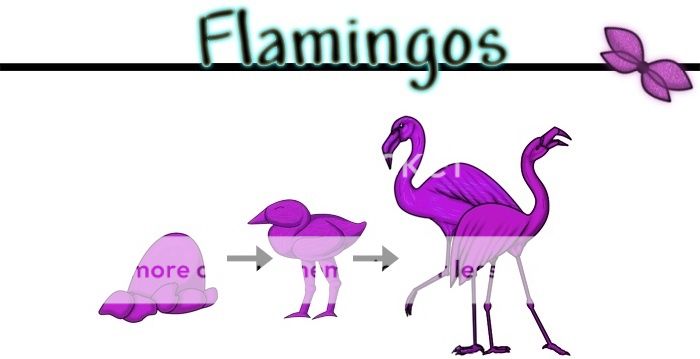
Flamingos often stand on one leg, the other tucked beneath the body. Flamingos filter-feed on brine shrimp and blue-green algae. Their beaks are specially adapted to separate mud and silt from the food they eat, and are uniquely used upside-down. Flamingos are very social birds that live in colonies that can number in the thousands. These large colonies are believed to serve three purposes for the flamingos; predator avoidance, maximizing food intake and exploiting scarce suitable nesting sites.
Sizes vary with types
Stages
Egg - Stage 1 - Joint Gender
Child - Stage 2 - Male and female forms
Adult - Stage 3 - Male and female forms
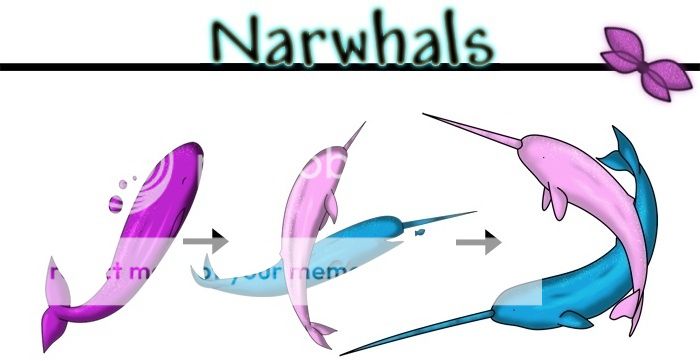
The narwhal is a uniquely specialized Arctic predator. In the winter, it feeds on benthic prey, mostly flatfish, at depths of up to 1500 m under dense pack ice. Narwhals exhibit seasonal migrations with high fidelity of return to preferred ice-free summering grounds. Narwhals normally congregate in groups of about five to ten individuals. In the summer, several groups come together forming larger aggregations. At times, male narwhals rub their tusks together in an activity called "tusking".
Sizes:
Male narwhals weigh up to 1,600 kilograms (3,500 lb), and the females weigh around 1,000 kilograms (2,200 lb).
The tusk can be up to 3 meters (9.8 ft) long—compared with a body length of 4–5 meters (13–16 ft)—and weigh up to 10 kilograms (22 lb). About one in 500 males has two tusks
Stages
Cub - Stage 1 - Joint gender
Teen - Stage 2 - Male and female forms
Adult - Stage 3 - Male and female forms
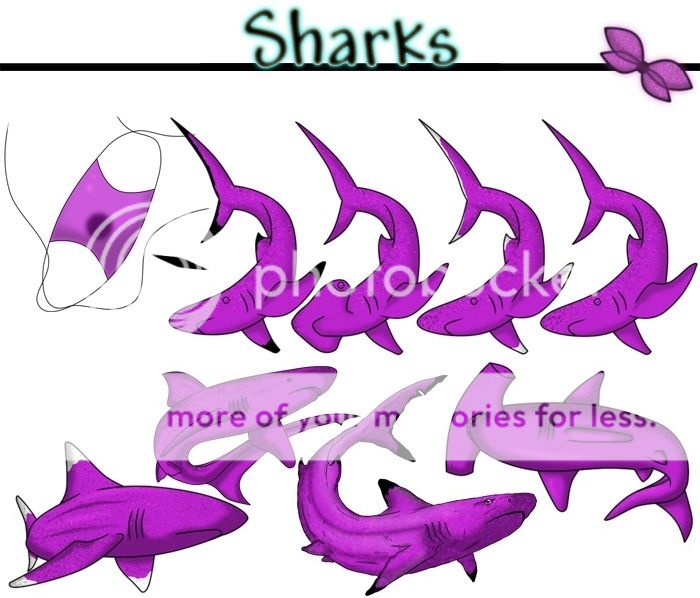
Black Tipped Reef Shark - White Tipped Reef Shark - Thresher Shark - Hammerhead Shark
Black Tipped Reef Shark - Most blacktip reef sharks are found over reef ledges and sandy flats, though they have also been known to enter brackish and freshwater environments. This species typically attains a length of 1.6 m (5.2 ft).
Its diet is composed primarily of small teleost fishes, including mullet, groupers, grunters, jacks, mojarras, wrasses, surgeonfish, and smelt-whitings. Squid, octopus, cuttlefish, shrimp, and mantis shrimp are also taken, as well as carrion and smaller sharks and rays, though this is rare.
White Tipped Reef Shark - Most reef sharks are found over reef ledges and sandy flats, though they have also been known to enter brackish and freshwater environments. This species typically attains a length of 1.6 m (5.2 ft).
Its diet is composed primarily of small teleost fishes, including mullet, groupers, grunters, jacks, mojarras, wrasses, surgeonfish, and smelt-whitings. Squid, octopus, cuttlefish, shrimp, and mantis shrimp are also taken, as well as carrion and smaller sharks and rays, though this is rare.
Thresher Shark - Named for and easily recognised by their exceptionally long, thresher-like tail or caudal fins (which can be as long as the total body length), thresher sharks are active predators; the tail is actually used as a weapon to stun prey.
Thresher Sharks may reach a length of 6.1 metres (20 ft) and a weight of over 500 kilograms (1,100 lb)
Thresher sharks are solitary creatures which keep to themselves.
Hammerhead Shark - t was determined recently that the hammer-like shape of the head evolved to enhance the animal's vision. The positioning of the eyes give the shark good binocular vision, as well as 360-degree vision in the vertical plane, meaning they can see above and below them at all times.
Like all sharks, hammerheads have electroreceptory sensory pores called ampullae of Lorenzini. By distributing the receptors over a wider area, hammerheads can sweep for prey more effectively.[5] These sharks have been able to detect an electrical signal of half a billionth of a volt. The hammer also allows the nostrils to be placed farther apart, increasing its ability to detect chemical gradients and localize the source.
Hammerhead sharks are known to eat a large range of items including fish, squid, octopus, crustaceans, and other hammerhead sharks. Stingrays are a particular favorite.
Hammerheads range from 0.9 to 6 m (3.0 to 20 ft) long and weigh from 500 to 1000 pounds.
Stages
Egg - Stage 1 - Joint Gender
Child - Stage 2 - Joint Gender
Adult - Stage 3 - Joint Gender

.
.
.

Pink = Female, Purple = Joint, Blue = Male
? = Not currently available

What’s more to say of rats, they crawl, they eat, they breed, and they sleep and get into almost everything, but what’s more they are masters of the food court. This is so much so that they are no longer seen as food, but rather the finders of food. The most common of the subtypes they are social beyond grouping in mass and guarding in full. There is many different types of rats, for different purposes.
One of the largest muroids, it is a rodent with a body up to 25 cm (10 in) long, and a similar tail length; the male weighs on average 350 g (12 oz) and the female 250 g (9 oz).
The length can be up to 25 cm (10 in), with the tail a further 25 cm (10 in), the same length as the body. Adult body weight averages 550 g (19 oz) in males and about 350 g (12 oz) in females, but a very large individual can reach 900 g (32 oz). Rats weighing over 1 kg (2.2 lb) are exceptional.
Rats have acute hearing, are sensitive to ultrasound, and possess a very highly developed olfactory sense. The vision of a pigmented rat is poor, around 20/600, while a non-pigmented (albino) with no melanin in its eyes has both around 20/1200 vision and a terrible scattering of light within its vision. rats are dichromates who perceive colours rather like a human with red-green colorblindness, and their colour saturation may be quite faint. Their blue perception, however, also has UV perceptors, allowing them to see ultraviolet lights that some species cannot.
The rat is usually active at night and is a good swimmer, both on the surface and underwater, they are poor climbers. rats dig well, and often excavate extensive burrow systems.
The rat is a true omnivore and will consume almost anything, but cereals form a substantial part of its diet.
Rats are known to burrow extensively, both in the wild and in captivity, if given access to a suitable substrate.
Burrows provide rats with shelter and food storage as well as safe, thermoregulated nest sites.Rats use their burrows to escape from perceived threats in the surrounding environment—for example, rats will retreat to their burrows following a sudden, loud noise or while fleeing an intruder.
This is why the home of the rats Rose thorp is actually located underground. Tho the tunnels have been made larger to be open to more larger creatures.
Rats often live in huge colony's with hundreds in population, A few larger are controlled by groups rather then a single member, rat colony's are often seen as a dictatorship how ever there are many that aren't. Rats are rarely seen alone.
Stages
Pinky - Stage 0? - Joint Gender - Only via breeding
Baby - Stage 1 - Joint Gender
Teen - Stage 2 - Male and female forms
Adult - Stage 3 - Male and female forms

The Ringtail (Bassariscus astutus) is a mammal of the raccoon family (thus not actually a cat)
The eyes are large and purple, each surrounded by a patch of light fur. It is smaller than a housecat, measuring 30–42 cm long with a tail of 31–44 cm and weighing 0.8–1.5 kg.
The ankle joint is flexible and able to rotate over 180 degrees, a trait helping make it an agile climber. Their considerable tail provides balance for negotiating narrow ledges and limbs, even allowing them to reverse directions by performing a cartwheel. Ringtails also can ascend narrow passages by stemming (pressing all feet on one wall and their back against the other or pressing both right feet on one wall and both left feet on the other), and wider cracks or openings by ricocheting between the walls.
This makes the ringtail one of the best scouts around the land.
It is nocturnal, solitary, timid, and rarely seen. It is omnivorous, eating fruits, berries, insects, lizards, small rodents, and birds. Owls, foxes, coyotes, raccoons and bobcats will prey upon ringtails.
Ringtail Cats are the acrobats of the subtypes and second most common, they can get to just about anywhere and in anything.
Ringtails often travel in pairs or solo they have a knack for exploring and are often the scouts of the area. Rarely are they seen in a large pack for very long.
Stages
Baby - Stage 1 - Joint Gender
Teen - Stage 2 - Male and female forms
Adult - Stage 3 - Male and female forms

Tanuki or raccoon dog which is the common name not mystical is a member of the canid family.
In reflection of their omnivorous diet, raccoon dogs have small and weak canines and carnassials, flat molars and relatively long intestines (1.5-2 times longer than other canids). They have long torsos and short legs. The tail is short, amounting to less than 1/3 of the animal's total length and hangs below the tarsal joints without touching the ground. The ears are short, and protrude only slightly from the fur. Weight fluctuates according to season; in March, they weigh 3 kg (6.6 lbs), while in August to early September, males average 6.5–7 kg (14-15 lbs), with some individuals attaining a maximal weight of 9–10 kg (20-22 lbs). Average adult head and body length is about 65 cm (2 ft)
Raccoon dogs are omnivores which feed on insects, mouse-like rodents, amphibians, birds, fish, reptiles, molluscs, carrion and insectivores. Frogs are the most commonly taken amphibians; Raccoon dogs will prey on waterfowl, passerines and migrating birds. Raccoon dogs will eat beached fish and fish trapped in small water bodies. They rarely catch fish during the spawning season, but will eat many during the spring thaw. Plant food is highly variable, and includes bulbs, rhizomes, oats, millets, maize, nuts, fruits, berries, grapes, melons, watermelons, pumpkins and tomatoes. they have been observed to climb trees to forage for fruits and berries; raccoon dogs use their curved claws to climb such trees.
Tanuki are considered demigods, these beasts are hardly seen, be them master of disguise or rare to the point of being not seen is unknown. Some claim they are able to shape shift others claim that is nothing but legend. The largest of the subtypes, it is mostly solitary coming together only to breed.
Stages
Baby - Stage 1 - Joint Gender
Child - Stage 2 - male and female forms
Adult - Stage 3 - male and female forms

Skunk species vary in size from about 15.6 to 37 inches (40 to 94 cm) and in weight from about 1.1 pounds (0.50 kg) to 18 pounds (8.2 kg). They have a moderately elongated body with relatively short, well-muscled legs, and long front claws for digging.
Skunks are omnivorous, eating both plant and animal material and changing their diet as the seasons change. They eat insects and larvae, earthworms, small rodents, lizards, salamanders, frogs, snakes, birds, moles, and eggs. They also commonly eat berries, roots, leaves, grasses, fungi, and nuts.
Skunks are crepuscular and are solitary animals when not breeding, though in the colder parts of their range they may gather in communal dens for warmth. During the day, they shelter in burrows that they dig with their powerful front claws, or in other man-made or natural hollows as the opportunity arises.
Skunks are probably one of the most dangerous even with out being a meat eater, their smell alone drives most away, having a chance to cause even blindness if taken wrong.
They are often used as guards and guard the opening to rose thorp.
Stages
Baby - Stage 1 - Joint Gender
Child - Stage 2 - Male and female forms
Adult - Stage 3 - Male and Female Forms

Stages
Baby - Stage 1 - Joint Gender
Teen - Stage 2 - Joint Gender
Adult - Stage 3 - Joint Gender

Large Breed Coyote - Small Breed Coyote
The original adult coyotes these tend to be larger and more aggressive then the new counter part. Often seen as the leaders of a pack they tend to be more out going.
Coyote alt adults are much smaller then the original in body mass they are normally quiet faster as they have less to move. Normally given beta ranking in packs or rarely alphas. They are more quiet less aggressive.
Coyotes are mostly nocturnal but seen during the day at some times, they normally hunt in pairs and form small groups. Coyotes are mostly carnivores eating small animals but will eat bugs at times also. Located in all areas including where humans inhabit they will eat even the dead tho they prefer fresh. - Litter size ranges from 1 to 19 pups
Coyotes typically grow up to 75–87 centimeters (30–34 inches) in length and on average, weigh from 7–21 kilograms (15–46 pounds)
Coyotes are pack livers as with most wolfs. Often you may hear one of these animals to never see him, able to stalk prey and confuse their enemies they are more advanced then coyotes of the normal world. But bear the same pack structure.
Alpha – Alpha
Beta – Beta
Gamma
Pups
Omega
Alpha male and female are always mates these are not fully leaders but normally the most out going causing others to follow.
Beta male and female are always mates also these just under the alphas are a form of second
Gammas are the middle coyote no one stands out no one wants to they are fit to follow and that’s all, those that aren’t beta alpha or omega are in this status
Omegas are the den guarders the lowest status of the pack they are often seen with tail down and ears down.
Stages
Baby - Stage 1 - Joint Gender
Child - Stage 2 - Male and female forms
Adult - Stage 3 - Male and female forms - The only Reject currently with 2 forms of adults

Large Breed Bobcat - Small Breed Bobcat
Though the Bobcat prefers rabbits and hares, it will hunt anything from insects and small rodents to deer. Prey selection depends on location and habitat, season, and abundance. Like most cats, the bobcat is territorial and largely solitary, although there is some overlap in home ranges. It uses several methods to mark its territorial boundaries, including claw marks and deposits of urine or feces.
The Bobcat is crepuscular. It keeps on the move from three hours before sunset until about midnight, and then again from before dawn until three hours after sunrise. Each night it will move from 2 to 7 miles (3.2 to 11 km) along its habitual route. This behavior may vary seasonally, as Bobcats become more diurnal during fall and winter. This is a response to the activity of their prey, which are more active during the day in colder months.
The adult male Bobcat is 28 to 40 inches (71 to 100 cm) long, averaging 35 inches (89 cm); with a stubby 4 to 7 inches (10 to 18 cm) tail, which has a "bobbed" appearance and gives the species its name. An adult stands about 20 to 24 inches (51 to 61 cm) at the shoulders. Adult males usually range from 20 to 30 pounds (9.1 to 14 kg); females average about 13 to 21 pounds (5.9 to 9.5 kg).The Bobcat is muscular, and its hind legs are longer than its front legs, giving it a bobbing gait. At birth it weighs 0.6 to 0.75 pound (270 to 340 g) and is about 10 inches (25 cm) in length. By its first year it will reach about 10 pounds (4.5 kg).
Stages
Baby - Stage 1 - Joint Gender
Child - Stage 2 - Male and female forms
Adult - Stage 3 - Male and female forms

Normal Lions - Barbary Lions - Rogue Lions
Pride standing:
All cubs when born are in the same pride as their parents. There are cubs born to nomads(Loners)
Bought Pets:
A lion bought from sales that have no pride are automatically given a Nomad standing till a pride is found or made.
Lions are the main inhabitant of the Savannah, Unmoved and unpredictable they cover all parts of the lands.
Lions are powerful animals that usually hunt in coordinated groups and stalk their chosen prey. However, they are not particularly known for their stamina they only run fast in short bursts and need to be close to their prey before starting the attack. They take advantage of factors that reduce visibility; many kills take place near some form of cover or at night. Typically, several lionesses work together and encircle the herd from different points. Once they have closed with a herd, they usually target the closest prey. The attack is short and powerful; they attempt to catch the victim with a fast rush and final leap. The prey usually is killed by strangulation. Smaller prey, though, may simply be killed by a swipe of a lion's paw.
The prey consists mainly of large mammals. Occasionally, they take relatively small species. Lions hunting in groups are capable of taking down most animals, even healthy adults.
Lions are predatory carnivores who manifest two types of social organization. Some are residents, living in groups, called prides. Prides may range from a newly formed group to a large group. Male cubs are excluded from their maternal pride when they reach maturity.
The second organizational behavior is labeled nomads, who range widely and move about sporadically, either singularly or in pairs. Pairs are more frequent among related males who have been excluded from their birth pride.
Lionesses do the majority of the hunting for their pride, being smaller, swifter and more agile than the males, and unencumbered by the heavy and conspicuous mane, which causes overheating during exertion. They act as a co-ordinated group in order to stalk and bring down the prey successfully. However, if nearby the hunt, males have a tendency to dominate the kill once the lionesses have succeeded.
Both males and females defend the pride against intruders. Some individual lions consistently lead the defense against intruders, while others lag behind. Lions tend to assume specific roles in the pride. Those lagging behind may provide other valuable services to the group.
- Normal Adult Lions
Weights for adult lions range between 150–250 kg (330–550 lb) for males and 120–182 kg (264–400 lb) for females.
Head and body length is 170–250 cm (5 ft 7 in – 8 ft 2 in) in males and 140–175 cm (4 ft 7 in – 5 ft 9 in) in females; shoulder height is about 123 cm (4 ft) in males and 107 cm (3 ft 6 in) in females. The tail length is 90–105 cm (2 ft 11 in - 3 ft 5 in) in males and 70–100 cm in females (2 ft 4 in – 3 ft 3 in).
- Barbary Adult lions
Much larger then a normal lion, and stronger
- Rogue Lions
Faster then both, but not as strong
Stages
Newborn - Stage 0? - Male and female forms - Only via breeding
Cub - Stage 1 - Male and Female Forms
Teen - Stage 2 - Male and female forms
Adult - Stage 3 - Male and female forms

Flamingos often stand on one leg, the other tucked beneath the body. Flamingos filter-feed on brine shrimp and blue-green algae. Their beaks are specially adapted to separate mud and silt from the food they eat, and are uniquely used upside-down. Flamingos are very social birds that live in colonies that can number in the thousands. These large colonies are believed to serve three purposes for the flamingos; predator avoidance, maximizing food intake and exploiting scarce suitable nesting sites.
Sizes vary with types
Stages
Egg - Stage 1 - Joint Gender
Child - Stage 2 - Male and female forms
Adult - Stage 3 - Male and female forms

The narwhal is a uniquely specialized Arctic predator. In the winter, it feeds on benthic prey, mostly flatfish, at depths of up to 1500 m under dense pack ice. Narwhals exhibit seasonal migrations with high fidelity of return to preferred ice-free summering grounds. Narwhals normally congregate in groups of about five to ten individuals. In the summer, several groups come together forming larger aggregations. At times, male narwhals rub their tusks together in an activity called "tusking".
Sizes:
Male narwhals weigh up to 1,600 kilograms (3,500 lb), and the females weigh around 1,000 kilograms (2,200 lb).
The tusk can be up to 3 meters (9.8 ft) long—compared with a body length of 4–5 meters (13–16 ft)—and weigh up to 10 kilograms (22 lb). About one in 500 males has two tusks
Stages
Cub - Stage 1 - Joint gender
Teen - Stage 2 - Male and female forms
Adult - Stage 3 - Male and female forms

Black Tipped Reef Shark - White Tipped Reef Shark - Thresher Shark - Hammerhead Shark
Black Tipped Reef Shark - Most blacktip reef sharks are found over reef ledges and sandy flats, though they have also been known to enter brackish and freshwater environments. This species typically attains a length of 1.6 m (5.2 ft).
Its diet is composed primarily of small teleost fishes, including mullet, groupers, grunters, jacks, mojarras, wrasses, surgeonfish, and smelt-whitings. Squid, octopus, cuttlefish, shrimp, and mantis shrimp are also taken, as well as carrion and smaller sharks and rays, though this is rare.
White Tipped Reef Shark - Most reef sharks are found over reef ledges and sandy flats, though they have also been known to enter brackish and freshwater environments. This species typically attains a length of 1.6 m (5.2 ft).
Its diet is composed primarily of small teleost fishes, including mullet, groupers, grunters, jacks, mojarras, wrasses, surgeonfish, and smelt-whitings. Squid, octopus, cuttlefish, shrimp, and mantis shrimp are also taken, as well as carrion and smaller sharks and rays, though this is rare.
Thresher Shark - Named for and easily recognised by their exceptionally long, thresher-like tail or caudal fins (which can be as long as the total body length), thresher sharks are active predators; the tail is actually used as a weapon to stun prey.
Thresher Sharks may reach a length of 6.1 metres (20 ft) and a weight of over 500 kilograms (1,100 lb)
Thresher sharks are solitary creatures which keep to themselves.
Hammerhead Shark - t was determined recently that the hammer-like shape of the head evolved to enhance the animal's vision. The positioning of the eyes give the shark good binocular vision, as well as 360-degree vision in the vertical plane, meaning they can see above and below them at all times.
Like all sharks, hammerheads have electroreceptory sensory pores called ampullae of Lorenzini. By distributing the receptors over a wider area, hammerheads can sweep for prey more effectively.[5] These sharks have been able to detect an electrical signal of half a billionth of a volt. The hammer also allows the nostrils to be placed farther apart, increasing its ability to detect chemical gradients and localize the source.
Hammerhead sharks are known to eat a large range of items including fish, squid, octopus, crustaceans, and other hammerhead sharks. Stingrays are a particular favorite.
Hammerheads range from 0.9 to 6 m (3.0 to 20 ft) long and weigh from 500 to 1000 pounds.
Stages
Egg - Stage 1 - Joint Gender
Child - Stage 2 - Joint Gender
Adult - Stage 3 - Joint Gender

Unwanted Rejects
(?)Community Member
- Report Post
- Posted: Wed, 16 Dec 2009 14:32:00 +0000
.
.
.
.
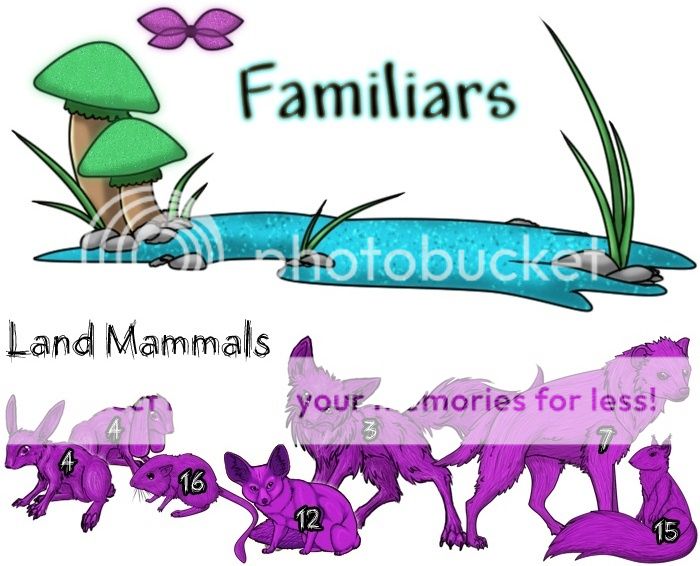
Fox ( 3 ) - The diet of foxes is largely made up of invertebrates. However, it also includes rodents, rabbits and other small mammals, reptiles, (such as snakes), amphibians, grasses, berries, fruit, fish, birds, eggs, and all other kinds of small animals. Many species are generalist predators, but some (such as the crab-eating fox) are more specialist.

Fennec Fox ( 12 ) - Fennec Fox is a small nocturnal fox. Its most distinctive feature is unusually large ears.
The Fennec Fox weighs about 1.5–3.5 lb (0.68–1.6 kg), with a body length of between 24–40 cm (9–16 in); it is around 20.3 cm (8 in) tall.[2] It is the smallest species of canid in the world.
The basic social unit is thought to be a mated pair and their offspring, and the young of the previous year are believed to remain in the family even after a new litter is born.
The Fennec Fox is a nocturnal omnivore. Food sources include rodents, insects, birds and eggs.[4] An individual can jump up to 2 ft (61 cm) high and 4 ft (120 cm) forward, which helps it catch prey and escape predators.

Hare( 4 ) - Very fast and skittish hares will only eat plant forms. These live in all areas.

Hyena ( 7 ) - Hyenas have relatively short torsos, and are fairly massive and wolf-like in build, but have lower hind quarters, high withers and their backs slope noticeably downward toward their croups. The forelegs are high, while the hind legs are very short and their necks are thick and short.
Hyenas are scavengers very rarely will they pack hunt.

Squirrel ( 15 ) - Squirrels are generally small animals, ranging in size from 7–10 cm (2.8–3.9 in) in length, and just 10 g (0.35 oz) in weight, to 53–73 cm (21–29 in) long, and weighs from 5 to 8 kg (11 to 18 lb).
must rely on foods rich in protein, carbohydrates, and fat.

Kangaroo Rat ( 16 ) - Kangaroo rats live in unknown environments in which food availability varies widely in space and time. The ability to hoard food is a vital adaptation. Food-hoarding is facilitated by the presence of external fur-lined cheek pouches that are used to transport food items from the harvest location to the storage site.
Their size varies from 10 to 20 cm, with a tail of equal or slightly greater length; the weight can be anywhere between 35 and 180 grams. The most distinctive feature of the kangaroo rats is their very long hind legs.


Great horned owl ( 8 ) - Owls have spectacular binocular vision allowing them to pinpoint prey and see in low light. The eyes of Great Horned Owls are nearly as large as those of humans and are immobile within their circular bone sockets. An owl's hearing is as good – if not better – than its vision. These birds hunt at night by waiting on a high perch and swooping down on prey. - They are carnivores.

Burrowing owl ( 6 ) - The Burrowing Owl is active in the daytime. It is found in grassland and desert scrub. - at 25 cm (10 inches) length, 53 cm (21 inches) wingspan, and 170g (6 oz)

Harpy Eagle ( 9 ) - This species is an actively hunting carnivore. Its main prey are tree-dwelling mammals
Female Harpy Eagles typically weigh 6.5 to 9 kg (14 to 20 lb). The male, in comparison, weighs only about 3.8 to 5.4 kg (8.4 to 12 lb). Harpy Eagles are 89–105 cm (2.9–3.4 ft) long and have a wingspan of approximately 200 cm (6 ft 7 in). although the wingspan of the Harpy Eagle is relatively small its an adaptation that increases maneuverability in forested habitats. The talons are up to 13 cm (5.1 in) long.

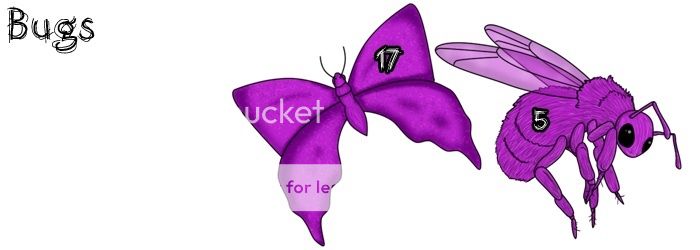
American Bumble Bee ( 5 ) - Bees are adapted for feeding on nectar and pollen, the former primarily as an energy source and the latter primarily for protein and other nutrients. Most bees are fuzzy and carry an electrostatic charge, which aids in the adherence of pollen.
Bees may be solitary or may live in various types of communities. The most advanced of these are eusocial colonies found among the honey bees, bumblebees, and stingless bees. Sociality, of several different types, is believed to have evolved separately many times within the bees.
In some species, groups of cohabiting females may be sisters, and if there is a division of labor within the group, then they are considered semi social.
Queen 21 - 25 mm
Worker 14 - 18 mm
Male 16 - 22 mm

Butterfly ( 17 ) - Butterflies have large, often brightly coloured wings, and conspicuous, fluttering flight.
Butterflies feed primarily on nectar from flowers. Some also derive nourishment from pollen, tree sap, rotting fruit, dung, decaying flesh, and dissolved minerals in wet sand or dirt.
Size varys greatly

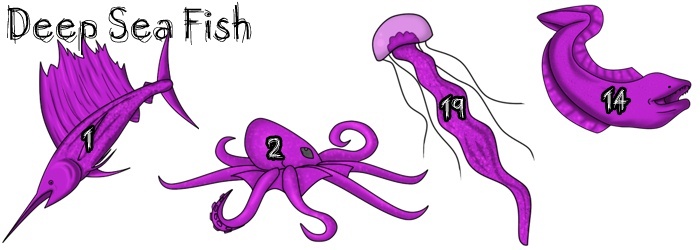
Sailfish ( 1 ) - sailfish grow quickly, reaching 1.2-1.5 m (4-5 ft) in length in a single year, and feed on the surface or at mid-depths on smaller pelagic forage fish and squid. Individuals have been clocked at speeds of up to 110 km/h (70 mph), which is the highest speed reliably reported in a fish.[2] [3] Generally, sailfish do not grow to more than 3 m (10 ft) in length and rarely weigh over 90 kg (200 lb).
The sail is normally kept folded down and to the side when swimming, but it may be raised when the sailfish feels threatened or excited, making the fish appear much larger than it actually is. This tactic has also been observed during feeding, when a group of sailfish use their sails to "herd" a school of fish or squid.

Moray Eel ( 14 ) - several species are regularly seen in brackish water and a few, can sometimes be found in freshwater.
With a maximum length of 11.5 centimetres (4.5 in) while the longest species reaches up to 4 metres (13 ft) The largest in terms of total mass reaches almost 3 metres (9.8 ft) and can weigh over 36 kilograms (79 lb).
Morays are carnivorous and feed primarily on other fish

Jellyfish ( 19 ) - Jellyfish are found in every ocean, from the surface to the deep sea. Some are even found in fresh water.

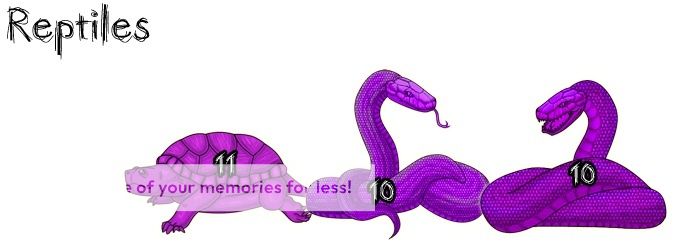
Snake ( 10) - A genus of large venomous snake in the family Elapidae. The total length may be up to 2.1 meters (7 ft). Males are larger then Females and thicker reaching lengths of almost 10ft at times.The snake uses venom to dispatch their prey, tho lacking in full size fang teeth and may bite an aggressor; they are potentially fatal to humans. Tolerant of low temperatures, the snake may be active on warmer nights.
These snakes are non-aggressive, and will often give warning strikes with a closed mouth. When threatened they will flatten their body and raise their head above the ground in a classic pre-strike stance.
Closely related to the king cobra this snake cares for its young which are born from eggs.
The babys have a length of 45 to 55 centimeters (18 to 22 in). They are highly aggressive and have already developed potent venom, which is as deadly as that of an adult.
Tho these snakes chose to prey mainly on rats they may attack anything.

Turtle ( 11 ) - Turtles vary in size reaching a shell length of 200 centimetres (6.6 ft) and can reach a weight of over 900 kilograms (2,000 lb). Freshwater turtles are generally smaller, a few individuals have been reported up to 200 centimetres (6.6 ft).
Turtles diet is rather open and it depends on the area

.
.
.

Fox ( 3 ) - The diet of foxes is largely made up of invertebrates. However, it also includes rodents, rabbits and other small mammals, reptiles, (such as snakes), amphibians, grasses, berries, fruit, fish, birds, eggs, and all other kinds of small animals. Many species are generalist predators, but some (such as the crab-eating fox) are more specialist.

Fennec Fox ( 12 ) - Fennec Fox is a small nocturnal fox. Its most distinctive feature is unusually large ears.
The Fennec Fox weighs about 1.5–3.5 lb (0.68–1.6 kg), with a body length of between 24–40 cm (9–16 in); it is around 20.3 cm (8 in) tall.[2] It is the smallest species of canid in the world.
The basic social unit is thought to be a mated pair and their offspring, and the young of the previous year are believed to remain in the family even after a new litter is born.
The Fennec Fox is a nocturnal omnivore. Food sources include rodents, insects, birds and eggs.[4] An individual can jump up to 2 ft (61 cm) high and 4 ft (120 cm) forward, which helps it catch prey and escape predators.

Hare( 4 ) - Very fast and skittish hares will only eat plant forms. These live in all areas.

Hyena ( 7 ) - Hyenas have relatively short torsos, and are fairly massive and wolf-like in build, but have lower hind quarters, high withers and their backs slope noticeably downward toward their croups. The forelegs are high, while the hind legs are very short and their necks are thick and short.
Hyenas are scavengers very rarely will they pack hunt.

Squirrel ( 15 ) - Squirrels are generally small animals, ranging in size from 7–10 cm (2.8–3.9 in) in length, and just 10 g (0.35 oz) in weight, to 53–73 cm (21–29 in) long, and weighs from 5 to 8 kg (11 to 18 lb).
must rely on foods rich in protein, carbohydrates, and fat.

Kangaroo Rat ( 16 ) - Kangaroo rats live in unknown environments in which food availability varies widely in space and time. The ability to hoard food is a vital adaptation. Food-hoarding is facilitated by the presence of external fur-lined cheek pouches that are used to transport food items from the harvest location to the storage site.
Their size varies from 10 to 20 cm, with a tail of equal or slightly greater length; the weight can be anywhere between 35 and 180 grams. The most distinctive feature of the kangaroo rats is their very long hind legs.


Great horned owl ( 8 ) - Owls have spectacular binocular vision allowing them to pinpoint prey and see in low light. The eyes of Great Horned Owls are nearly as large as those of humans and are immobile within their circular bone sockets. An owl's hearing is as good – if not better – than its vision. These birds hunt at night by waiting on a high perch and swooping down on prey. - They are carnivores.

Burrowing owl ( 6 ) - The Burrowing Owl is active in the daytime. It is found in grassland and desert scrub. - at 25 cm (10 inches) length, 53 cm (21 inches) wingspan, and 170g (6 oz)

Harpy Eagle ( 9 ) - This species is an actively hunting carnivore. Its main prey are tree-dwelling mammals
Female Harpy Eagles typically weigh 6.5 to 9 kg (14 to 20 lb). The male, in comparison, weighs only about 3.8 to 5.4 kg (8.4 to 12 lb). Harpy Eagles are 89–105 cm (2.9–3.4 ft) long and have a wingspan of approximately 200 cm (6 ft 7 in). although the wingspan of the Harpy Eagle is relatively small its an adaptation that increases maneuverability in forested habitats. The talons are up to 13 cm (5.1 in) long.


American Bumble Bee ( 5 ) - Bees are adapted for feeding on nectar and pollen, the former primarily as an energy source and the latter primarily for protein and other nutrients. Most bees are fuzzy and carry an electrostatic charge, which aids in the adherence of pollen.
Bees may be solitary or may live in various types of communities. The most advanced of these are eusocial colonies found among the honey bees, bumblebees, and stingless bees. Sociality, of several different types, is believed to have evolved separately many times within the bees.
In some species, groups of cohabiting females may be sisters, and if there is a division of labor within the group, then they are considered semi social.
Queen 21 - 25 mm
Worker 14 - 18 mm
Male 16 - 22 mm

Butterfly ( 17 ) - Butterflies have large, often brightly coloured wings, and conspicuous, fluttering flight.
Butterflies feed primarily on nectar from flowers. Some also derive nourishment from pollen, tree sap, rotting fruit, dung, decaying flesh, and dissolved minerals in wet sand or dirt.
Size varys greatly


Sailfish ( 1 ) - sailfish grow quickly, reaching 1.2-1.5 m (4-5 ft) in length in a single year, and feed on the surface or at mid-depths on smaller pelagic forage fish and squid. Individuals have been clocked at speeds of up to 110 km/h (70 mph), which is the highest speed reliably reported in a fish.[2] [3] Generally, sailfish do not grow to more than 3 m (10 ft) in length and rarely weigh over 90 kg (200 lb).
The sail is normally kept folded down and to the side when swimming, but it may be raised when the sailfish feels threatened or excited, making the fish appear much larger than it actually is. This tactic has also been observed during feeding, when a group of sailfish use their sails to "herd" a school of fish or squid.

Moray Eel ( 14 ) - several species are regularly seen in brackish water and a few, can sometimes be found in freshwater.
With a maximum length of 11.5 centimetres (4.5 in) while the longest species reaches up to 4 metres (13 ft) The largest in terms of total mass reaches almost 3 metres (9.8 ft) and can weigh over 36 kilograms (79 lb).
Morays are carnivorous and feed primarily on other fish

Jellyfish ( 19 ) - Jellyfish are found in every ocean, from the surface to the deep sea. Some are even found in fresh water.


Snake ( 10) - A genus of large venomous snake in the family Elapidae. The total length may be up to 2.1 meters (7 ft). Males are larger then Females and thicker reaching lengths of almost 10ft at times.The snake uses venom to dispatch their prey, tho lacking in full size fang teeth and may bite an aggressor; they are potentially fatal to humans. Tolerant of low temperatures, the snake may be active on warmer nights.
These snakes are non-aggressive, and will often give warning strikes with a closed mouth. When threatened they will flatten their body and raise their head above the ground in a classic pre-strike stance.
Closely related to the king cobra this snake cares for its young which are born from eggs.
The babys have a length of 45 to 55 centimeters (18 to 22 in). They are highly aggressive and have already developed potent venom, which is as deadly as that of an adult.
Tho these snakes chose to prey mainly on rats they may attack anything.

Turtle ( 11 ) - Turtles vary in size reaching a shell length of 200 centimetres (6.6 ft) and can reach a weight of over 900 kilograms (2,000 lb). Freshwater turtles are generally smaller, a few individuals have been reported up to 200 centimetres (6.6 ft).
Turtles diet is rather open and it depends on the area

Unwanted Rejects
(?)Community Member
- Report Post
- Posted: Wed, 16 Dec 2009 14:33:09 +0000
.
.
.
.

Each god will have a area they rein over
As in maybe ones god of anger another is god of love
However no two areas can be exactly the same
So you can have
God of anger
God of hate
But not two gods with the title god of anger or hate
However you can have (This is because of being each gender - They arent required to be mates)
God of hate
Goddess of hate
Gods all have a area they rein over
Ranking of gods
Olympian gods - These can not be used it will be a event
Greater gods(Edited lines to fit the element - These are set to what they rein over already by colorist) - Rein over main elements - Fire, water, earth, Darkness so on
Lesser gods(edited or not edited - Users pick what they Rein other) - Rein over things under them - Sparks, Tidal waves, Flowers, Shadows so on
Gods of Emotion(edited or not edited - Users pick what they Rein other) - Rein over feelings, Love, Hate, Sadness, Fear
Holiday Gods Holiday gods are special and can not be customed and already have a set area to which they rein over these are edited pets based after that holiday (God of easter, God of christmas, God of halloween)
Users get to pick the area they rein over, Thats if the colorist has not however unless the pet is edited and fits that area they can not be greater gods
~~~~~~~~~~~~~~
List of current reining areas
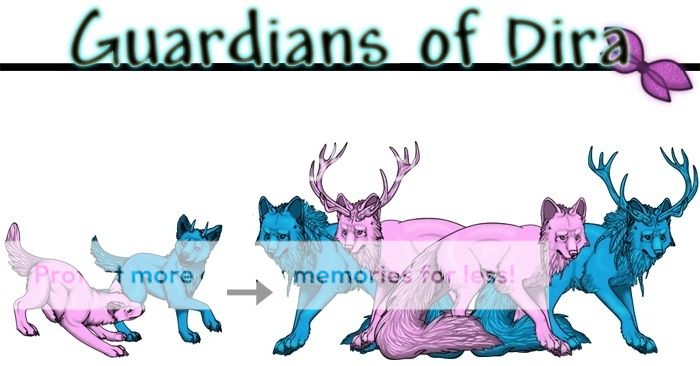
Stages
Baby - Stage 1 - Joint gender
Child - Stage 2 - Male and female forms
Adult - Stage 3 - Male and female forms
Stages Elders
This is via Rp Coyotes being either large or small breed may change into Guardians of Dira

.
.
.

Each god will have a area they rein over
As in maybe ones god of anger another is god of love
However no two areas can be exactly the same
So you can have
God of anger
God of hate
But not two gods with the title god of anger or hate
However you can have (This is because of being each gender - They arent required to be mates)
God of hate
Goddess of hate
Gods all have a area they rein over
Ranking of gods
Olympian gods - These can not be used it will be a event
Greater gods(Edited lines to fit the element - These are set to what they rein over already by colorist) - Rein over main elements - Fire, water, earth, Darkness so on
Lesser gods(edited or not edited - Users pick what they Rein other) - Rein over things under them - Sparks, Tidal waves, Flowers, Shadows so on
Gods of Emotion(edited or not edited - Users pick what they Rein other) - Rein over feelings, Love, Hate, Sadness, Fear
Holiday Gods Holiday gods are special and can not be customed and already have a set area to which they rein over these are edited pets based after that holiday (God of easter, God of christmas, God of halloween)
Users get to pick the area they rein over, Thats if the colorist has not however unless the pet is edited and fits that area they can not be greater gods
~~~~~~~~~~~~~~
List of current reining areas

Stages
Baby - Stage 1 - Joint gender
Child - Stage 2 - Male and female forms
Adult - Stage 3 - Male and female forms
Stages Elders
This is via Rp Coyotes being either large or small breed may change into Guardians of Dira

Unwanted Rejects
(?)Community Member
- Report Post
- Posted: Wed, 16 Dec 2009 14:34:08 +0000
.
.
.
.

(Familiars)
Unlike normal familiars these have bonus's Depending on the type added to a pet it may be an extra breeding or even a curse of all boys or all girls
Demi gods do not rein over anything, These are familiars. However Demi gods add powers to the one they are bonded to. If they arent bonded to anyone that power doesnt effect anyone.
Users do not get to pick powers, if theres no special power added then its rando'd between the default powers at the time the pet is certed.
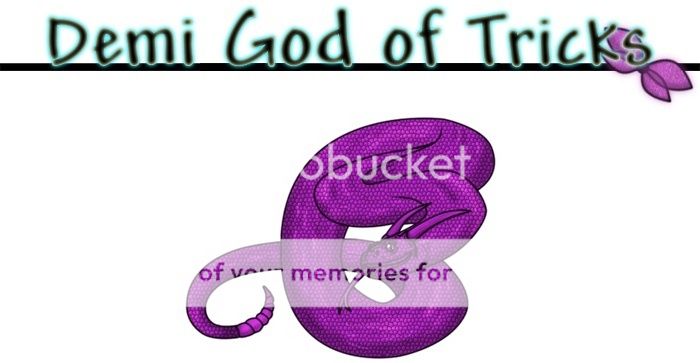
Snake Demi God
Snakes are tricksters they find fun in confusing those around them. These have gained the ability to fly, or dig fast, swim fast or even all of them. They are larger then most snakes and reach lengths of a school bus.
~ powers
(1. Number of babies is hidden)
(2. Odd random colors to babies)
(3. Genders is hidden till they grow)
(4. 1 Less baby from breedings)
(5. No Power added)
Stages
Adult - Joint gender
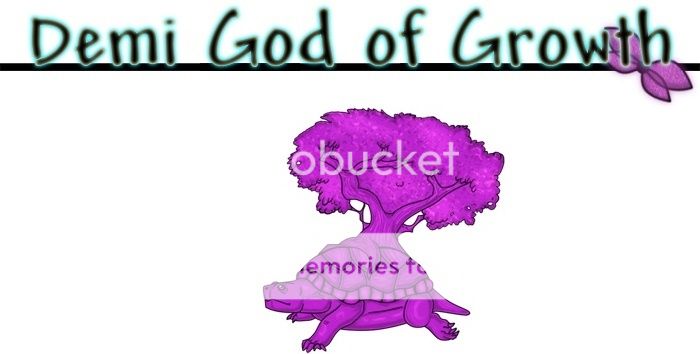
Turtle Demi God
As they get older a odd plant grows on there back forming later a tree, They are known to live forever and no one knows how old they get. They can still swim tho not well. they are able to bury them selfs till just the tree is seen blending them totally in.
~ powers
(1. Start growth)
(2. Slower growth, for pet and babys)
(3. Extra Baby from Breedings)
(4. Keep 1 extra baby from breedings)
(5. No Power added)
Stages
Adult - Joint gender
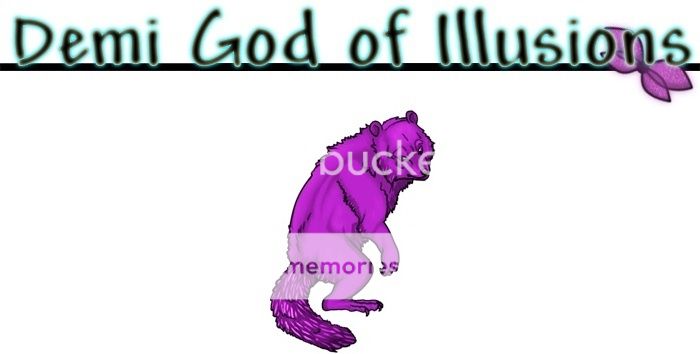
Coon Bear Demi God
What you see is not always true with these guys. They hide there form or even something as small as a rock so you trip over it. They rarely speak the truth however you cant always tell if its a lie either.
~ powers
(1. stop growth)
(2. Fake breeding child count)
(3. Offspring fake baby colored)
(4. Gender unknown till babys grow)
(5. No Power added)
Stages
Adult - Joint gender
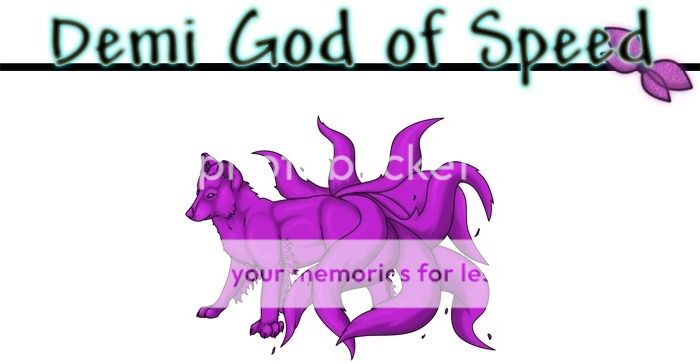
Fox Demi God
The fox demi god is a physical form of fire. Fast and wild it often cant be controlled. They have perfect control over how the fire burns and arent effected by water as a normal fire would be.
~ powers
(1. Skipping of teen/child stage)
(2. Offspring skip baby stage)
(3. Faster growth)
(4. Pet can breed even if babies arent grown)
(5. No Power added)
Stages
Adult - Joint gender

.
.
.

(Familiars)
Unlike normal familiars these have bonus's Depending on the type added to a pet it may be an extra breeding or even a curse of all boys or all girls
Demi gods do not rein over anything, These are familiars. However Demi gods add powers to the one they are bonded to. If they arent bonded to anyone that power doesnt effect anyone.
Users do not get to pick powers, if theres no special power added then its rando'd between the default powers at the time the pet is certed.

Snake Demi God
Snakes are tricksters they find fun in confusing those around them. These have gained the ability to fly, or dig fast, swim fast or even all of them. They are larger then most snakes and reach lengths of a school bus.
~ powers
(1. Number of babies is hidden)
(2. Odd random colors to babies)
(3. Genders is hidden till they grow)
(4. 1 Less baby from breedings)
(5. No Power added)
Stages
Adult - Joint gender

Turtle Demi God
As they get older a odd plant grows on there back forming later a tree, They are known to live forever and no one knows how old they get. They can still swim tho not well. they are able to bury them selfs till just the tree is seen blending them totally in.
~ powers
(1. Start growth)
(2. Slower growth, for pet and babys)
(3. Extra Baby from Breedings)
(4. Keep 1 extra baby from breedings)
(5. No Power added)
Stages
Adult - Joint gender

Coon Bear Demi God
What you see is not always true with these guys. They hide there form or even something as small as a rock so you trip over it. They rarely speak the truth however you cant always tell if its a lie either.
~ powers
(1. stop growth)
(2. Fake breeding child count)
(3. Offspring fake baby colored)
(4. Gender unknown till babys grow)
(5. No Power added)
Stages
Adult - Joint gender

Fox Demi God
The fox demi god is a physical form of fire. Fast and wild it often cant be controlled. They have perfect control over how the fire burns and arent effected by water as a normal fire would be.
~ powers
(1. Skipping of teen/child stage)
(2. Offspring skip baby stage)
(3. Faster growth)
(4. Pet can breed even if babies arent grown)
(5. No Power added)
Stages
Adult - Joint gender

Unwanted Rejects
(?)Community Member
- Report Post
- Posted: Wed, 16 Dec 2009 14:35:11 +0000
.
.
.
.

 Do not kill other peoples pets. Pets don't die unless decided different by owner.
Do not kill other peoples pets. Pets don't die unless decided different by owner.
 Do not rp with other peoples pets.
Do not rp with other peoples pets.
 These rules go for staff and customers.
These rules go for staff and customers.
 When doing an open RP in the main thread, be careful to not overlook others wanting to join in!
When doing an open RP in the main thread, be careful to not overlook others wanting to join in!
 Roleplay is not required but highly encouraged.
Roleplay is not required but highly encouraged.
 Roleplaying must be done in English.
Roleplaying must be done in English.
 Respect your partners and their feelings. This includes remembering that just because two pets may hate each other, doesn't mean the other owner hates you.
Respect your partners and their feelings. This includes remembering that just because two pets may hate each other, doesn't mean the other owner hates you.
 Animals have a free speech even with humans.
Animals have a free speech even with humans.
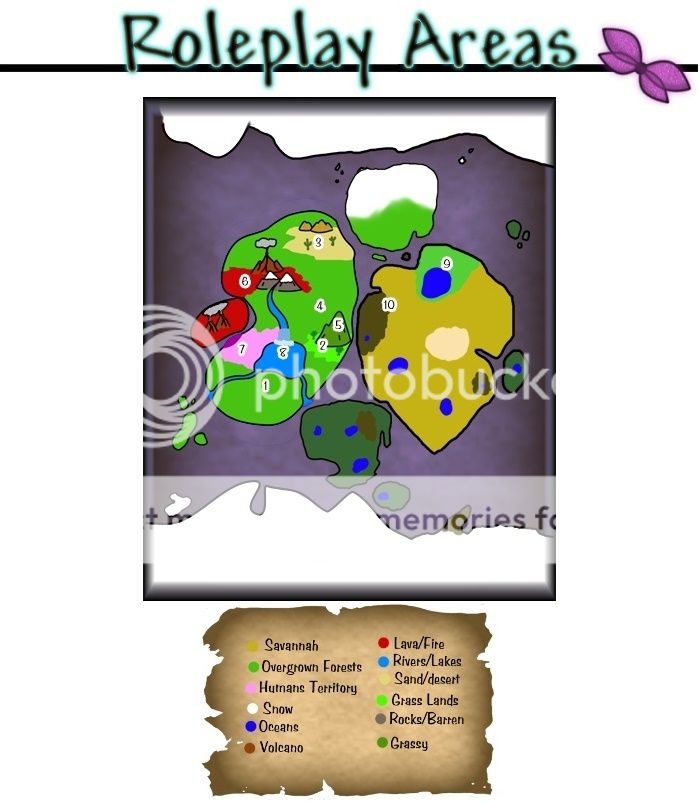
Wild grown forests - As the name shows, these forests are often overgrown with no marking only ones are trails made by animals.
Nakoda Desert - Dry and plain as with most deserts, many Ringtailed cats choose this as their home.
Firey void - This land is always heated. Lava fields are common and the air is always clogged and dark. However, as it's seen as a land of doom, the volcano is the creator of the island. The lava rushes to the shore, only to harden which is increasing the land mass slowly.
Dira Peak - Green and lush, this mountain towers above all. It's seen as a place for the gods.
The Great Lake - The main body of fresh water of the island. This lake stretches far and wide. Home to a wide variety of fish, it is the main hunting area seeing how it is safe from the larger predators of the sea.
Crystal Falls - Clear and powerful, it drops almost 50 feet into the great lake which then forms into the rivers and flows into the ocean.
3 branching rivers - There are only three main rivers on the island, but there may be many streams.
Western Shore - Western shore is where most humans seem to find themselves. This area for most animals is now a death trap. However, there are many animals born here, knowing nothing but a human. And not all humans are cruel.
Savannah:
Savannahs are often dry. Rain doesn't come often, but the summer months bare the most and floods and monsoon rains begin. Many animals call this land their home. Savannahs are flat plain-like areas that stretch for miles. They have a warm temperature year around.
Rain forests:
Rain forests, like the savannah, are warm year-around. Though unlike that of the savannah, they are wet year-around. This is where most herbs and medicines also come from.
Snow:
Cold, snowy, and windy best describes this land. It never unfreezes and temperatures are always low. Animal life are those fit to live through the cold and wind, and plant life is scarce.
Badlands:
Badlands are where the land has all but died. Littered with bones and stumps of trees, very few animals call this land their home. However there are a few. Animals here tend to be more skittish, more hostile, and more likely to attack.
Grasslands:
Grasslands are large, rolling terrains of grasses, flowers and herbs. Rain is rather common and more plants can grow here than in savannahs.
Rivers and lakes:
Sand and deserts:
The hottest and driest area. The days are very hot and the nights are freezing. Most animals and plant life can go a long time without water, as it rarely falls.
~~~~~~~~~~~~~~
Guild Rp Thread

.
.
.

 Do not kill other peoples pets. Pets don't die unless decided different by owner.
Do not kill other peoples pets. Pets don't die unless decided different by owner. Do not rp with other peoples pets.
Do not rp with other peoples pets. These rules go for staff and customers.
These rules go for staff and customers. When doing an open RP in the main thread, be careful to not overlook others wanting to join in!
When doing an open RP in the main thread, be careful to not overlook others wanting to join in! Roleplay is not required but highly encouraged.
Roleplay is not required but highly encouraged. Roleplaying must be done in English.
Roleplaying must be done in English. Respect your partners and their feelings. This includes remembering that just because two pets may hate each other, doesn't mean the other owner hates you.
Respect your partners and their feelings. This includes remembering that just because two pets may hate each other, doesn't mean the other owner hates you. Animals have a free speech even with humans.
Animals have a free speech even with humans.
Wild grown forests - As the name shows, these forests are often overgrown with no marking only ones are trails made by animals.
Nakoda Desert - Dry and plain as with most deserts, many Ringtailed cats choose this as their home.
Firey void - This land is always heated. Lava fields are common and the air is always clogged and dark. However, as it's seen as a land of doom, the volcano is the creator of the island. The lava rushes to the shore, only to harden which is increasing the land mass slowly.
Dira Peak - Green and lush, this mountain towers above all. It's seen as a place for the gods.
The Great Lake - The main body of fresh water of the island. This lake stretches far and wide. Home to a wide variety of fish, it is the main hunting area seeing how it is safe from the larger predators of the sea.
Crystal Falls - Clear and powerful, it drops almost 50 feet into the great lake which then forms into the rivers and flows into the ocean.
3 branching rivers - There are only three main rivers on the island, but there may be many streams.
Western Shore - Western shore is where most humans seem to find themselves. This area for most animals is now a death trap. However, there are many animals born here, knowing nothing but a human. And not all humans are cruel.
Savannah:
Savannahs are often dry. Rain doesn't come often, but the summer months bare the most and floods and monsoon rains begin. Many animals call this land their home. Savannahs are flat plain-like areas that stretch for miles. They have a warm temperature year around.
Rain forests:
Rain forests, like the savannah, are warm year-around. Though unlike that of the savannah, they are wet year-around. This is where most herbs and medicines also come from.
Snow:
Cold, snowy, and windy best describes this land. It never unfreezes and temperatures are always low. Animal life are those fit to live through the cold and wind, and plant life is scarce.
Badlands:
Badlands are where the land has all but died. Littered with bones and stumps of trees, very few animals call this land their home. However there are a few. Animals here tend to be more skittish, more hostile, and more likely to attack.
Grasslands:
Grasslands are large, rolling terrains of grasses, flowers and herbs. Rain is rather common and more plants can grow here than in savannahs.
Rivers and lakes:
Sand and deserts:
The hottest and driest area. The days are very hot and the nights are freezing. Most animals and plant life can go a long time without water, as it rarely falls.
~~~~~~~~~~~~~~
Guild Rp Thread

Unwanted Rejects
(?)Community Member
- Report Post
- Posted: Wed, 16 Dec 2009 14:36:09 +0000
.
.
.
.
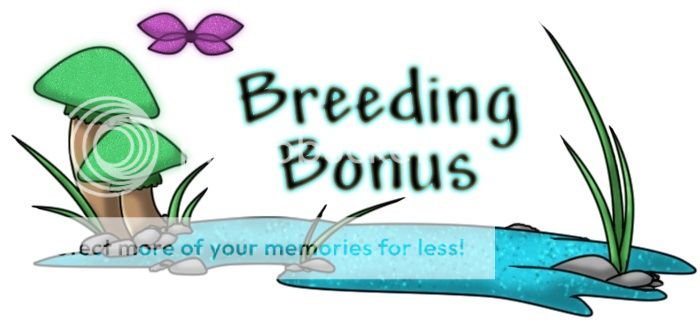
SECTION PENDING A REWRITE.
Users that rp are given bonuses for breeds.
They may usually be extra babies.
There may also be joint breeding from Rps however there are some requirements. The babies will not be a cross new breed they will be one or the other, decided on by dice.
 This is binding, like marriage
This is binding, like marriage
 Couples that are said as mate my not breed with anyone but that mate
Couples that are said as mate my not breed with anyone but that mate
 Mated couples get 2 more babies per breeding then normal breeding. This doesn't require rp.
Mated couples get 2 more babies per breeding then normal breeding. This doesn't require rp.
 Ways to take off mates, Death of one of the pets, meaning they can no longer rp or breed basically just a pretty, or pay 100k
Ways to take off mates, Death of one of the pets, meaning they can no longer rp or breed basically just a pretty, or pay 100k
.
.
.

SECTION PENDING A REWRITE.
Users that rp are given bonuses for breeds.
They may usually be extra babies.
There may also be joint breeding from Rps however there are some requirements. The babies will not be a cross new breed they will be one or the other, decided on by dice.
Rp requirements:
 To have an Rp count there must be documented proof.
To have an Rp count there must be documented proof.
 Rps must be a page or longer, but the colorist doign the bredding gets to decide the bonuses its worth.
Rps must be a page or longer, but the colorist doign the bredding gets to decide the bonuses its worth.
 Users may rp with their own pets
Users may rp with their own pets
 Rps between pets must have something of the kind to where the babies come from (cant be just random )
Rps between pets must have something of the kind to where the babies come from (cant be just random )
 Posts may not be tiny (Ren: why *he said*) or (why *he said*) They must be an attempt at least one paragraph or a bit smaller
Posts may not be tiny (Ren: why *he said*) or (why *he said*) They must be an attempt at least one paragraph or a bit smaller
 If you own and Rp both parents, you may keep 3 babies, 2 if you don't.
If you own and Rp both parents, you may keep 3 babies, 2 if you don't.
 To have an Rp count there must be documented proof.
To have an Rp count there must be documented proof. Rps must be a page or longer, but the colorist doign the bredding gets to decide the bonuses its worth.
Rps must be a page or longer, but the colorist doign the bredding gets to decide the bonuses its worth. Users may rp with their own pets
Users may rp with their own pets Rps between pets must have something of the kind to where the babies come from (cant be just random )
Rps between pets must have something of the kind to where the babies come from (cant be just random ) Posts may not be tiny (Ren: why *he said*) or (why *he said*) They must be an attempt at least one paragraph or a bit smaller
Posts may not be tiny (Ren: why *he said*) or (why *he said*) They must be an attempt at least one paragraph or a bit smaller If you own and Rp both parents, you may keep 3 babies, 2 if you don't.
If you own and Rp both parents, you may keep 3 babies, 2 if you don't.Breeding Groups: (New)
Under water mammals - This would be whales dolphins
Fish - Sharks, Eels so forth
Mammals - Coyotes, bobcats so forth (Slight limit - Deer types wouldnt be able to breed with canine types)
Birds - owls and eagles and so forth
Reptiles - Snakes, turtles and so forth
Bugs - Bees and so forth
Amphibians - Frogs and so forth
(This is for all types gods demi gods familiars)

Under water mammals - This would be whales dolphins
Fish - Sharks, Eels so forth
Mammals - Coyotes, bobcats so forth (Slight limit - Deer types wouldnt be able to breed with canine types)
Birds - owls and eagles and so forth
Reptiles - Snakes, turtles and so forth
Bugs - Bees and so forth
Amphibians - Frogs and so forth
(This is for all types gods demi gods familiars)

 This is binding, like marriage
This is binding, like marriage Couples that are said as mate my not breed with anyone but that mate
Couples that are said as mate my not breed with anyone but that mate Mated couples get 2 more babies per breeding then normal breeding. This doesn't require rp.
Mated couples get 2 more babies per breeding then normal breeding. This doesn't require rp. Ways to take off mates, Death of one of the pets, meaning they can no longer rp or breed basically just a pretty, or pay 100k
Ways to take off mates, Death of one of the pets, meaning they can no longer rp or breed basically just a pretty, or pay 100kTo apply for mate status

Pending a rewrite.
Groups add bonus's to breedings
If one parent is in a group its +1 to the litter size
If both parents are in the same group its +2 to the litter size
These are not given
Babies become
3 - 6
4 - 6


Pending a rewrite.
Groups add bonus's to breedings
If one parent is in a group its +1 to the litter size
If both parents are in the same group its +2 to the litter size
These are not given
Babies become
3 - 6
4 - 6

Unwanted Rejects
(?)Community Member
- Report Post
- Posted: Wed, 16 Dec 2009 14:37:14 +0000
.
.
.
.

SECTION LIKELY BEING DONE AWAY WITH
 Once a pet picks a pack/herd/colony they must stick to that, Unless you make a really good reason as why they should change. (rp reasoning often is a plus, mate, death what not)
Once a pet picks a pack/herd/colony they must stick to that, Unless you make a really good reason as why they should change. (rp reasoning often is a plus, mate, death what not)
 To set up a pack you must first pm the mule with the requirements:
To set up a pack you must first pm the mule with the requirements:
 However you may set up a thread there for it. However make sure to add closed to the title till it is approved by me.
However you may set up a thread there for it. However make sure to add closed to the title till it is approved by me.
 Babies born to parents in a group will also be in that group
Babies born to parents in a group will also be in that group
 Packs are not required however they may make more means for rps, breedings, and all out be fun.
Packs are not required however they may make more means for rps, breedings, and all out be fun.

Amasai Pride (Lions)
Hashim Obi Pride (Lions)
Moon Stalkers Pack (Coyotes)
Bone Chewers Pack (Coyotes)
Silver Fang Pack (Coyotes)
Children of Dira (Coyotes)
Rose Thorp (Small Rodents, Mainly Rats)

Creating a group

.
.
.

SECTION LIKELY BEING DONE AWAY WITH
 Once a pet picks a pack/herd/colony they must stick to that, Unless you make a really good reason as why they should change. (rp reasoning often is a plus, mate, death what not)
Once a pet picks a pack/herd/colony they must stick to that, Unless you make a really good reason as why they should change. (rp reasoning often is a plus, mate, death what not) To set up a pack you must first pm the mule with the requirements:
To set up a pack you must first pm the mule with the requirements: However you may set up a thread there for it. However make sure to add closed to the title till it is approved by me.
However you may set up a thread there for it. However make sure to add closed to the title till it is approved by me. Babies born to parents in a group will also be in that group
Babies born to parents in a group will also be in that group Packs are not required however they may make more means for rps, breedings, and all out be fun.
Packs are not required however they may make more means for rps, breedings, and all out be fun.
Amasai Pride (Lions)
Hashim Obi Pride (Lions)
Moon Stalkers Pack (Coyotes)
Bone Chewers Pack (Coyotes)
Silver Fang Pack (Coyotes)
Children of Dira (Coyotes)
Rose Thorp (Small Rodents, Mainly Rats)

Creating a group

Unwanted Rejects
(?)Community Member
- Report Post
- Posted: Wed, 16 Dec 2009 14:38:12 +0000
.
.
.
.

Flatsales:
General Flatsale Rules
 Do not post until the start time given, all forms before this go will not count
Do not post until the start time given, all forms before this go will not count
 Payment is expected within 24 hours after the confirmed unless talked about before (failure to do so will result in reselling of pet)
Payment is expected within 24 hours after the confirmed unless talked about before (failure to do so will result in reselling of pet)
 Certing info needs posted immediately.
Certing info needs posted immediately.
 After you win post info in the Certing Thread
After you win post info in the Certing Thread
Speed Flatsale Rules
 Do not edit posts
Do not edit posts
 You may proxy for someone and claim one for your self, however you have to use two separate posts.
You may proxy for someone and claim one for your self, however you have to use two separate posts.
 If there are still pets left over and you all ready claimed one, you must wait 24 hours until you may claim another.
If there are still pets left over and you all ready claimed one, you must wait 24 hours until you may claim another.
Flaffle Rules
 Flaffles will remain open for the duration of the time specified at the time of FS.
Flaffles will remain open for the duration of the time specified at the time of FS.
 Pref's are expected at the time of ordering, you may proxy but they are still expected
Pref's are expected at the time of ordering, you may proxy but they are still expected
 You may only win one if there is a lack of entries. Winners will be picked and the rest thrown back in the pot.
You may only win one if there is a lack of entries. Winners will be picked and the rest thrown back in the pot.
 Entry ticket is free however if you win you are expected to send a trade for after. (expected 24 hours after end time or will be rerolled)
Entry ticket is free however if you win you are expected to send a trade for after. (expected 24 hours after end time or will be rerolled)
~~~~~~~~~~~~~~~~~~~~~~~~~~~~~~~~~~~
Raffles:
Raffles are often special pets, they can be sold in a group or as one. Users may only get one pet per raffle, unless otherwise stated. The win is based off of luck of the dice.
Raffle Rules
 Raffle tickets will usually be 100 gold each, unless otherwise stated. There will be instructions on getting tickets posted for each raffle
Raffle tickets will usually be 100 gold each, unless otherwise stated. There will be instructions on getting tickets posted for each raffle
 You must complete trades for the tickets BEFORE the raffle is drawn or they will be canceled and the tickets wont count
You must complete trades for the tickets BEFORE the raffle is drawn or they will be canceled and the tickets wont count
 Trades are to be sent to the mule, not the colorists
Trades are to be sent to the mule, not the colorists
 When and if a new pet is added users may change there prefs. Prefs not changed when drawn after the warning will be given by order of prefs and rerolled if that pet won isnt on their prefs
When and if a new pet is added users may change there prefs. Prefs not changed when drawn after the warning will be given by order of prefs and rerolled if that pet won isnt on their prefs
 After you win post info in the Certing Thread
After you win post info in the Certing Thread
~~~~~~~~~~~~~~~~~~~~~~~~~~~~~~~~~~~
Auctions:
Auction Rules
 Payment must be received within 48 hours unless there are EXTREME circumstances that you tell me about
Payment must be received within 48 hours unless there are EXTREME circumstances that you tell me about
 Post the code when making your bid
Post the code when making your bid
 Co-bidding is allowed if there is more then one pet if not no. (this is just for auctions)
Co-bidding is allowed if there is more then one pet if not no. (this is just for auctions)
 Items are accepted at there CURRENT lowest going price (note if it goes up after you bid tough till someone out bids you you dont get to change it, How ever if this drops then just means you get off better)
Items are accepted at there CURRENT lowest going price (note if it goes up after you bid tough till someone out bids you you dont get to change it, How ever if this drops then just means you get off better)
 After you win post info in the Certing Thread
After you win post info in the Certing Thread
~~~~~~~~~~~~~~~~~~~~~~~~~~~~~~~~~~~
In-thread Games:
~~~~~~~~~~~~~~~~~~~~~~~~~~~~~~~~~~~
Customs:
Customs are as they sound custom pets. Slots open when a colorist chooses to open them, at first come, first serve.
 Read the rules in the individual colorist rules.
Read the rules in the individual colorist rules.
 Do not harass colorists about a pending custom, or to open more slots.
Do not harass colorists about a pending custom, or to open more slots.
 Trade must be started before a custom can be begun.
Trade must be started before a custom can be begun.
To find out about slots read the colorist's page (links below):
~~~~~~~~~~~~~~~~~~~~~~~~~~~~~~~~~~~
Breeding:
Breedings are between two owners and they get 4 babies, users may only keep 2 which often means there may be games or extras giving away.
 Read the rules in the individual colorist rules.
Read the rules in the individual colorist rules.
 Do not harass colorists about a pending custom, or to open more slots.
Do not harass colorists about a pending custom, or to open more slots.
 Trade must be started before a custom can be begun.
Trade must be started before a custom can be begun.
To find out about slots read the colorist's page (links below):

.
.
.

Flatsales:
General Flatsale Rules
 Do not post until the start time given, all forms before this go will not count
Do not post until the start time given, all forms before this go will not count Payment is expected within 24 hours after the confirmed unless talked about before (failure to do so will result in reselling of pet)
Payment is expected within 24 hours after the confirmed unless talked about before (failure to do so will result in reselling of pet) Certing info needs posted immediately.
Certing info needs posted immediately. After you win post info in the Certing Thread
After you win post info in the Certing ThreadSpeed Flatsale Rules
 Do not edit posts
Do not edit posts You may proxy for someone and claim one for your self, however you have to use two separate posts.
You may proxy for someone and claim one for your self, however you have to use two separate posts. If there are still pets left over and you all ready claimed one, you must wait 24 hours until you may claim another.
If there are still pets left over and you all ready claimed one, you must wait 24 hours until you may claim another.Flaffle Rules
 Flaffles will remain open for the duration of the time specified at the time of FS.
Flaffles will remain open for the duration of the time specified at the time of FS. Pref's are expected at the time of ordering, you may proxy but they are still expected
Pref's are expected at the time of ordering, you may proxy but they are still expected You may only win one if there is a lack of entries. Winners will be picked and the rest thrown back in the pot.
You may only win one if there is a lack of entries. Winners will be picked and the rest thrown back in the pot. Entry ticket is free however if you win you are expected to send a trade for after. (expected 24 hours after end time or will be rerolled)
Entry ticket is free however if you win you are expected to send a trade for after. (expected 24 hours after end time or will be rerolled)~~~~~~~~~~~~~~~~~~~~~~~~~~~~~~~~~~~
Raffles:
Raffles are often special pets, they can be sold in a group or as one. Users may only get one pet per raffle, unless otherwise stated. The win is based off of luck of the dice.
Raffle Rules
 Raffle tickets will usually be 100 gold each, unless otherwise stated. There will be instructions on getting tickets posted for each raffle
Raffle tickets will usually be 100 gold each, unless otherwise stated. There will be instructions on getting tickets posted for each raffle You must complete trades for the tickets BEFORE the raffle is drawn or they will be canceled and the tickets wont count
You must complete trades for the tickets BEFORE the raffle is drawn or they will be canceled and the tickets wont count Trades are to be sent to the mule, not the colorists
Trades are to be sent to the mule, not the colorists When and if a new pet is added users may change there prefs. Prefs not changed when drawn after the warning will be given by order of prefs and rerolled if that pet won isnt on their prefs
When and if a new pet is added users may change there prefs. Prefs not changed when drawn after the warning will be given by order of prefs and rerolled if that pet won isnt on their prefs After you win post info in the Certing Thread
After you win post info in the Certing Thread~~~~~~~~~~~~~~~~~~~~~~~~~~~~~~~~~~~
Auctions:
Auction Rules
 Payment must be received within 48 hours unless there are EXTREME circumstances that you tell me about
Payment must be received within 48 hours unless there are EXTREME circumstances that you tell me about Post the code when making your bid
Post the code when making your bid Co-bidding is allowed if there is more then one pet if not no. (this is just for auctions)
Co-bidding is allowed if there is more then one pet if not no. (this is just for auctions) Items are accepted at there CURRENT lowest going price (note if it goes up after you bid tough till someone out bids you you dont get to change it, How ever if this drops then just means you get off better)
Items are accepted at there CURRENT lowest going price (note if it goes up after you bid tough till someone out bids you you dont get to change it, How ever if this drops then just means you get off better) After you win post info in the Certing Thread
After you win post info in the Certing Thread~~~~~~~~~~~~~~~~~~~~~~~~~~~~~~~~~~~
In-thread Games:
~~~~~~~~~~~~~~~~~~~~~~~~~~~~~~~~~~~
Customs:
Customs are as they sound custom pets. Slots open when a colorist chooses to open them, at first come, first serve.
 Read the rules in the individual colorist rules.
Read the rules in the individual colorist rules. Do not harass colorists about a pending custom, or to open more slots.
Do not harass colorists about a pending custom, or to open more slots. Trade must be started before a custom can be begun.
Trade must be started before a custom can be begun.To find out about slots read the colorist's page (links below):
~~~~~~~~~~~~~~~~~~~~~~~~~~~~~~~~~~~
Breeding:
Breedings are between two owners and they get 4 babies, users may only keep 2 which often means there may be games or extras giving away.
 Read the rules in the individual colorist rules.
Read the rules in the individual colorist rules. Do not harass colorists about a pending custom, or to open more slots.
Do not harass colorists about a pending custom, or to open more slots. Trade must be started before a custom can be begun.
Trade must be started before a custom can be begun.To find out about slots read the colorist's page (links below):

Unwanted Rejects
(?)Community Member
- Report Post
- Posted: Wed, 16 Dec 2009 14:39:03 +0000
.
.
.
.

Green Mushrooms

Extra baby from breeding(This may be put right into the breeding form it doesn't have to be its own form) - This will add one more for sure baby to a breeding, say the dice said only 2 this will add one for sure making it 3! How ever this must be bought before/During the breeding and the colorist must be informed of this. (cannot be bought for a breeding after that breeding has been rolled)
Limit: 1 per owner per breeding
Cost: 3000g

Gella Flower
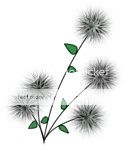
1 Twin via a breeding: This will guaranty that one baby from your breeding is a twin (does not effect the total count of a breeding)
Limit: 1 per owner per breeding
Cost: 7000g

Items: - These are made after you have got a pet, like you got a flatsale pet but want to add an item to them. A bracelet, so on. However these will go up in price and vary depending on the item you want made.
Cost: 2000g (simple items, A bracelet, a necklace that is simple) Price goes up from there, Its up to the colorist that makes it.

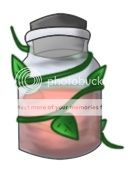
Perma Potion: Have a perma you really want to grow up this is just for you. But it wont be cheap.
Cost: no edits 20k edits 40k
Limits: 5/5 left
These are instant effects, they do work on grams understand user gets no say over edits but they will be like the perma.

Form can be posted in the thread or pmed trade are to be sent to the mule
Also Note extra breeding potions can be bought at the time of a breeding.
Form:

.
.
.

Green Mushrooms

Extra baby from breeding(This may be put right into the breeding form it doesn't have to be its own form) - This will add one more for sure baby to a breeding, say the dice said only 2 this will add one for sure making it 3! How ever this must be bought before/During the breeding and the colorist must be informed of this. (cannot be bought for a breeding after that breeding has been rolled)
Limit: 1 per owner per breeding
Cost: 3000g

Gella Flower

1 Twin via a breeding: This will guaranty that one baby from your breeding is a twin (does not effect the total count of a breeding)
Limit: 1 per owner per breeding
Cost: 7000g

Items: - These are made after you have got a pet, like you got a flatsale pet but want to add an item to them. A bracelet, so on. However these will go up in price and vary depending on the item you want made.
Cost: 2000g (simple items, A bracelet, a necklace that is simple) Price goes up from there, Its up to the colorist that makes it.


Perma Potion: Have a perma you really want to grow up this is just for you. But it wont be cheap.
Cost: no edits 20k edits 40k
Limits: 5/5 left
These are instant effects, they do work on grams understand user gets no say over edits but they will be like the perma.

Form can be posted in the thread or pmed trade are to be sent to the mule
Also Note extra breeding potions can be bought at the time of a breeding.
Form:
Url of the pet to have the item:
Type of item:
Full cost:
Type of item:
Full cost:

Unwanted Rejects
(?)Community Member
- Report Post
- Posted: Wed, 16 Dec 2009 14:40:00 +0000
.
.
.
.


.
.
.

Do i Direct link?
 Absolutely not, under any circumstance.
Absolutely not, under any circumstance.
Is there a limit to the amount I can own?
 There is no limit to the amount you may own
There is no limit to the amount you may own
Are these rp required?
 No.
No.
I had a breeding can I sale the other offspring?
 No in no shape or form may you make money off anything in this shop unless you are staff, however you may still suggest an auction or normal raffle that costs money that money how ever goes to the colorist not you.
No in no shape or form may you make money off anything in this shop unless you are staff, however you may still suggest an auction or normal raffle that costs money that money how ever goes to the colorist not you.
What is a perma?
 Permas are made on one stage only not adult, this can be a teen, baby, or child as the colorist sees fit. Grams are often in forms of permas.
Permas are made on one stage only not adult, this can be a teen, baby, or child as the colorist sees fit. Grams are often in forms of permas.
What are the limits to a perma? Can I buy a start growth for it?
 No unlike a pet where you stop its growth the stages before are done, its already a growing pet. Permas are like adults in type however they may not breed. They may have familiars be rped but can not change from that form.
No unlike a pet where you stop its growth the stages before are done, its already a growing pet. Permas are like adults in type however they may not breed. They may have familiars be rped but can not change from that form.
If I win a pet from a sale does it have to go in a pride?
 No, all pets unless breeding or said otherwise are rogues when first bought.
No, all pets unless breeding or said otherwise are rogues when first bought.
(more will be added when seen fit)
 Absolutely not, under any circumstance.
Absolutely not, under any circumstance.Is there a limit to the amount I can own?
 There is no limit to the amount you may own
There is no limit to the amount you may ownAre these rp required?
 No.
No.I had a breeding can I sale the other offspring?
 No in no shape or form may you make money off anything in this shop unless you are staff, however you may still suggest an auction or normal raffle that costs money that money how ever goes to the colorist not you.
No in no shape or form may you make money off anything in this shop unless you are staff, however you may still suggest an auction or normal raffle that costs money that money how ever goes to the colorist not you.What is a perma?
 Permas are made on one stage only not adult, this can be a teen, baby, or child as the colorist sees fit. Grams are often in forms of permas.
Permas are made on one stage only not adult, this can be a teen, baby, or child as the colorist sees fit. Grams are often in forms of permas.What are the limits to a perma? Can I buy a start growth for it?
 No unlike a pet where you stop its growth the stages before are done, its already a growing pet. Permas are like adults in type however they may not breed. They may have familiars be rped but can not change from that form.
No unlike a pet where you stop its growth the stages before are done, its already a growing pet. Permas are like adults in type however they may not breed. They may have familiars be rped but can not change from that form.If I win a pet from a sale does it have to go in a pride?
 No, all pets unless breeding or said otherwise are rogues when first bought.
No, all pets unless breeding or said otherwise are rogues when first bought.(more will be added when seen fit)

Unwanted Rejects
(?)Community Member
- Report Post
- Posted: Wed, 16 Dec 2009 14:40:45 +0000
.
.
.
.

























Eden's Paradise



.
.
.


[url=http://tinyurl.com/y9qdh88][IMG]http://i831.photobucket.com/albums/zz231/UnwantedRejectsBanners/200x40-Banner-1.jpg[/IMG][/url]

[url=http://tinyurl.com/y9qdh88][IMG]http://i831.photobucket.com/albums/zz231/UnwantedRejectsBanners/200x40-Banner-2.jpg[/IMG][/url]






















Eden's Paradise



Unwanted Rejects
(?)Community Member
- Report Post
- Posted: Wed, 16 Dec 2009 14:41:36 +0000
.
.
.
.

Established: April 27, 2009
Lion Lines bought on 1-11-11
OrliDeppgrl1526 - Co-Owner, Colorist
Fayt_of_Redemption - Co-Owner, Colorist
purrrplekitty - Co-Owner, Colorist

Rat/Ringtail/Skunk Female/Tanuki Female Teen/ Tanuki Adults, Bobcats, Coyotes, Burrowing Owl, Fox, Great horned owl(Small) Lines : BasiliskZero
Rat, Ringtails, Skunk child and adult female, Skunk baby, Tanuki Adults, Tanuki Female child Shading: BasiliskZero
Bobcats, Coyotes, Fox, Burrowing Owl, Great horned owl (Small), Harpy Eagle New Templets: slimycrow
Harpy eagle, Bumblebee sketches copyright Scoptic
Tanuki baby and alt teen, skunk alt teen and alt adult - LadyNekoya
Tanuki baby, alt teen, Skunk male Templeting and inking by keliptis
Sailfish, Snakes, Flamingo, Hyena copyright by keliptis
Lion/Fennect Fox Lineart/inking: Kiniro Oniba
Male Normal and Barbary Lion shading: Brittlebear
Female Normal Lion/Male Rogue/Fennec Fox Shading: keliptis
Guardians of Dira sketchs (c) Kaelyndra
Guardian of Dira inking and shading (c) keliptis
Coon-bear, Snake(Demi god), Turtle(Demi god) sketchs (c) Scoptic (formally known as Vaij)
Coon-bear, Snake(Demi god), Turtle(Demi god) Inking and shading (c) keliptis
Banners: keliptis
Cert: Zukuro-Chan, Keliptis
Story/Concept: keliptis
Rp story and starter plot: Ornithkiree/keliptis/bullterrierlove/wolfpuppies
Most real facts come from Wikipedia
Old shop thread

.
.
.

Established: April 27, 2009
Lion Lines bought on 1-11-11
OrliDeppgrl1526 - Co-Owner, Colorist
Fayt_of_Redemption - Co-Owner, Colorist
purrrplekitty - Co-Owner, Colorist

Rat/Ringtail/Skunk Female/Tanuki Female Teen/ Tanuki Adults, Bobcats, Coyotes, Burrowing Owl, Fox, Great horned owl(Small) Lines : BasiliskZero
Rat, Ringtails, Skunk child and adult female, Skunk baby, Tanuki Adults, Tanuki Female child Shading: BasiliskZero
Bobcats, Coyotes, Fox, Burrowing Owl, Great horned owl (Small), Harpy Eagle New Templets: slimycrow
Harpy eagle, Bumblebee sketches copyright Scoptic
Tanuki baby and alt teen, skunk alt teen and alt adult - LadyNekoya
Tanuki baby, alt teen, Skunk male Templeting and inking by keliptis
Sailfish, Snakes, Flamingo, Hyena copyright by keliptis
Lion/Fennect Fox Lineart/inking: Kiniro Oniba
Male Normal and Barbary Lion shading: Brittlebear
Female Normal Lion/Male Rogue/Fennec Fox Shading: keliptis
Guardians of Dira sketchs (c) Kaelyndra
Guardian of Dira inking and shading (c) keliptis
Coon-bear, Snake(Demi god), Turtle(Demi god) sketchs (c) Scoptic (formally known as Vaij)
Coon-bear, Snake(Demi god), Turtle(Demi god) Inking and shading (c) keliptis
Banners: keliptis
Cert: Zukuro-Chan, Keliptis
Story/Concept: keliptis
Rp story and starter plot: Ornithkiree/keliptis/bullterrierlove/wolfpuppies
Most real facts come from Wikipedia
Old shop thread




